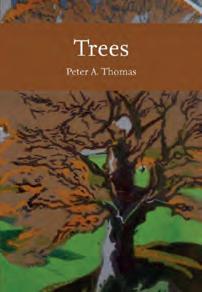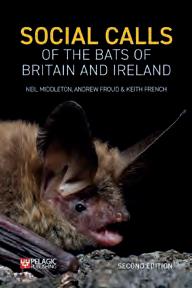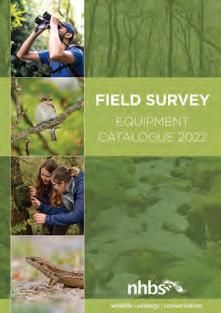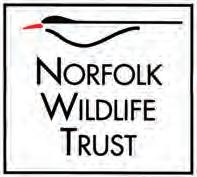
SUMMER 2022


Young photographers shine See the winning entries in our Young People’s Photography Competition
Bringing Norfolk’s woodland back
Restoring lost woodland connectivity Explore NWT Foxley Wood Visit the county’s largest ancient woodland




Young photographers shine See the winning entries in our Young People’s Photography Competition
Bringing Norfolk’s woodland back
Restoring lost woodland connectivity Explore NWT Foxley Wood Visit the county’s largest ancient woodland
Walking is one of the most beneficial forms of exercise, and also one of the most underestimated in terms of well-being. It’s a great way to reach the recommended level of physical activity needed to stay healthy without the toll to joints, ligaments and muscles that more demanding sports exact.
But taking long walks can become difficult for some of us. Paul Goddard, 63, a Nordic Walking instructor from Saffron Walden in Essex, swears by a product called Turmeric+ as an effective means of keeping him active.
“I decided to become a Nordic Walking instructor in 2009 and started walking forty to fi fty miles a week. Two years ago it became uncomfortable to walk distances that should have been easy for someone of my age and fi tness levels. I felt very apprehensive as walking is not only my passion, but my business.”
Paul continues: “I started doing some research. I learned that
turmeric could be helpful and bought supplements… and then stumbled upon Turmeric+.”
Curcumin, the active ingredient in turmeric, is difficult for the body to absorb. Some turmeric products offer high levels of curcumin but unless this is easily absorbed by the body, the higher amounts make little difference.
The need for easy absorption is what led the scientists at FutureYou Cambridge to create Turmeric+ using the patented ‘Curcuma Phospholipid Complex’ formulation. It’s thirty times more absorbable than standard turmeric and contains vitamin C, which contributes to normal collagen formation
“Soon after taking it I experienced that ‘light-bulb’ moment”

for the normal function of cartilage.
“Soon after taking it I experienced that ‘light-bulb’ moment - I realised my knees felt like they used to. I take Turmeric+ religiously now. I walk around two hundred miles a month and even my customers have remarked on my mobility.
“Walking is great for fi tness as well as your mental health. Being able to walk easily has made a huge difference to my
life and I feel fi tter now than I did twenty years ago.”
Adam Cleevely, CEO of FutureYou Cambridge comments:
“We want to support more people to get active and we think Turmeric+ can play an important role in that journey. We have tens of thousands of happy Turmeric+ subscribers who regularly tell us about their positive stories, just like Paul.”
Just pay £1.50 postage
FutureYou Cambridge are renowned for developing the highest quality health supplements backed by leading scientific research. The Cambridge-based company, who actively work with highly-regarded scientific and nutritional experts, is offering you the opportunity to try its bestselling joint supplement, Turmeric+, for free, for 28 days.*


















Turmeric+ contains the most scientifically documented bioavailable curcumin formulation in existence,
having been the focus of 45 human studies involving over 2,000 subjects. It has also been officially recognised and certified by Informed-Sport.
The patented curcuma phospholipid complex formulation features a unique phytosome delivery system to significantly increase curcumin bioavailability; an advanced natural alternative to black pepper. Pharmacokinetics studies show it enhances curcumin absorption by 30 times.
The vegan-friendly formula contains the full bouquet of curcuminoids including high levels of demethoxycurcumin (DMC), the most powerful curcuminoid. It has also been combined with vitamin C which contributes
to normal collagen formation for the normal function of cartilage.
‘We want to support more people to become or stay active. We think Turmeric+ can play an important role in that journey.
‘We offer people their first pack of Turmeric+ for free so they can experience the high quality, patented curcumin formulation for themselves. Most will know if it’s working for them within four to eight weeks – and if they like it, they will stick with it.’ says Adam Cleevely, FutureYou Cambridge’s CEO.
‘I’ve been genuinely amazed by the effect of Turmeric+. It’s transformative. As far as I’m concerned, I’ll be taking it for the rest of my life.’ said James, 54, from London.








Norfolk Wildlife Trust is a charity dedicated to all aspects of wildlife conservation in Norfolk. Established in 1926, we are the oldest in a partnership of 47 Wildlife Trusts located throughout the UK.
As a member of NWT, you will help us to create a Living Landscape for Norfolk, where there is more space for wildlife, better connection of wildlife habitats and where people live healthier, more sustainable lives. You will help us look after more than 50 fantastic nature reserves, ensuring they remain havens for wildlife and people.
If you are not already a member of NWT, please join today. Alternatively, you could give membership as a rewarding and worthwhile gift to a friend or relative. To become a member from as little as £3 a month you can:
• Visit our website www.norfolkwildlifetrust.org.uk
• Call us on 01603 625540
• Ask a member of staff at one of our five visitor centres
Tern is published three times a year by Norfolk Wildlife Trust. Advertising sales by Countrywide Publications and printed by Micropress Printers Ltd.
Editor: Nick Acheson
Designer: Hannah Moulton
While every care is taken when accepting advertisements neither Norfolk Wildlife Trust nor Countrywide Publications can accept responsibility for unsatisfactory transactions which arise. The views expressed in this magazine are those of the contributors and not necessarily those of Norfolk Wildlife Trust.
NORFOLK WILDLIFE TRUST
Bewick House, 22 Thorpe Road, Norwich NR1 1RY, UK
T: 01603 625540 F: 01603 598300
E: info@norfolkwildlifetrust.org.uk www.norfolkwildlifetrust.org.uk
All contents © Norfolk Wildlife Trust.
Reg Charity No: 208734
Cover photo: David Tipling
Welcome to a woodland-themed issue of Tern. Woods are one of my favourite habitats to explore in summer, with their dappled shade, woodland flora and butterflies flitting between branches.
With The Queen as our Patron, it is particularly fitting for us to join The Queen’s Green Canopy (QGC). Inviting people to ‘Plant a Tree for the Jubilee,’ this is a unique initiative to mark Her Majesty’s Platinum Jubilee in 2022. We are guardians of some very special ancient woodland in Norfolk and in this edition you can find out how — alongside local communities — we are managing and restoring woods and creating new woodland too.
Summer is also a brilliant time of year for visiting the sea. As National Marine Week approaches, it’s the perfect time for us to focus on marine wildlife. Read on for tips on protecting wildlife on your beach visits this summer, for marine events for all the family, and to learn how we’re involved in the conversation about protecting marine wildlife from increasing human pressures.

This spring we launched our very first young person’s photography competition, which was a great success. It was inspiring to see the passion and creativity of the next generation, taking their first steps towards being the conservationists of the future. Enjoy the winning entries in our feature on page 31.
We are currently in the middle of a consultation on the legal targets for nature’s recovery under the new Environment Act. It’s fantastic that we have such legally-binding targets, but we think they could be much more ambitious, befitting the nature emergency in which we find ourselves. Despite this, we can all take action, whether it’s in a window box, a garden, a community space or, for the lucky few (see our article on the Wedding Wood), by planting your own woodland!


Earlier this year we came to you with a vision for a flagship nature reserve in Norwich. Esmée Fairbairn Foundation had purchased 90 acres of precious habitat on the edge of the River Wensum, and we appealed for your help to bring it into our subsequent ownership and care and to begin plans for its restoration.
Sweet Briar Marshes offers a unique opportunity to protect wildlife in an urban setting, and to create a treasured wild place with better access to nature for local communities.
Our plans are ambitious, and their success relies on raising no less than £600,000, but thankfully we are not alone in our mission.
Armed with a shared desire to support biodiversity and strengthen communities in Norwich, our campaign partners Aviva promise to match appeal donations pound for
pound — meaning every contribution will work twice as hard — and, since launching in February, we’ve received an incredible response from our members and the wider community.
We’re touched by this support, which at the time of writing approaches £150,000 (with a matched value of £300,000, thanks to Aviva). We could not be more grateful to the Geoffrey Watling Charity, the Paul Bassham Charitable Trust and to all those who have already answered our plea.
You can still donate online, by cheque, over the phone or in our visitor centres, or perhaps you’d like to help by volunteering or fundraising.
To find out more, you can visit norfolkwildlifetrust.org.uk/appeal or speak to our Fundraising Team on 01603 625540. However you choose to make your contribution, we’d love to hear from you.
Perhaps the most tranquil way to enjoy the beauty of NWT Hickling Broad is to take the Hickling Water Trail and meander the backwaters of the reserve on board our boat, Swallowtail. This year, with the reintroduction of an electric engine, the experience will be still more peaceful. With our other boats, Damselfly and Little Tern, Swallowtail’s new motor completes the electrification of the Trust’s public boats.
Over 15 years ago, when our Explorer boats were introduced, they were propelled by an electric system. Over time, the technology proved insufficiently robust. As no other electric sysytem was then available, the decision was made to move to conventional outboards.
For some time, we have wanted to return to a more sustainable system. With the introduction of a new electric engine from manufacturers Barrus Shire, we can now realise that ambition. The new engines have been installed this winter by Cox’s Boatyard, an NWT Investor in Wildlife, and they have been in operation since the start of the season.
The introduction of electric engines has been made possible largely by a grant from the People’s Postcode Lottery and is in line with NWT’s sustainability strategy. This year, visitors will again be able to hear the gentle pinging of bearded tits in the reed and the low whir of dragonflies quartering the dykes. More information on the boats running at Hickling and Ranworth can be found at norfolkwildlifetrust.org.uk
This year we have said a fond farewell to Dick Wingate, who was volunteer promoter of our 250 Club lottery for 11 years. We thank him for many memorable draws together, both in person and while we had to move online during the pandemic.
Dick has been a tireless and committed champion of the 250 Club, and his dedication has led to many improvements in its running. Even after officially standing down, he has continued to help us, stepping in to sign prize cheques when banking challenges arose during the handover. We hope Dick can now truly retire from his 250 Club duties and enjoy spending more time with his family and writing his series of novels.
‘After a nine-year stint as an NWT trustee,’ Dick says, ‘I have maintained a productive and very happy relationship with staff at headquarters through my role as volunteer promoter of the 250 Club. In particular I’ve worked with the fundraising team and Lucy Denman, who has provided wonderful support. I wish Amanda every success as the new promoter.’
We are delighted to welcome Amanda Morris as our new volunteer promoter.

A primary school teacher for many years, Amanda spends most of her time developing her wildlife garden with her husband Lee and exploring Norfolk’s coast and nature reserves, where pinkfooted geese are a particular favourite.
‘I am looking forward to running the 250 Club lottery in conjunction with NWT,’ Amanda says. ‘It’s lovely to be able to support the Trust’s work preserving Norfolk’s wonderful habitats, both for wildlife and for everyone to visit and enjoy.’
The 250 Club raises essential funds for NWT land restoration projects. Prize Draws take place in February and July. To join the 250 Club in time for the next prize draw on 29 July 2022, please visit norfolkwildlifetrust.org.uk/250club
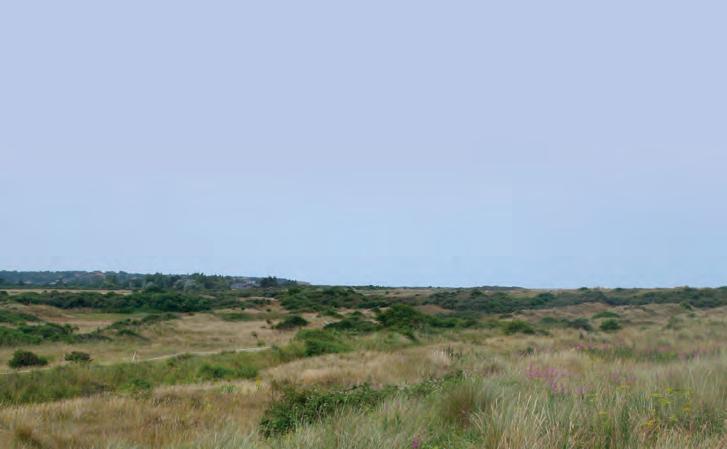
Three of the UK’s native oil beetles have become extinct here and the remaining five have suffered declines in numbers and distribution. Oil beetles are remarkable insects with fascinating life cycles. Their main requirements are bare ground within flower-rich grassland, together with a strong population of solitary bees.
Female oil beetles lay their eggs in burrows dug into compacted soil. When the louse-like black larva (known as a triungulin) emerges, it climbs onto a nearby flower and sits among the petals, waiting for a ground-nesting solitary bee to arrive. It then hitches a ride on the bee to her nest. Once in the nest, it disembarks and begins to feed on its host’s eggs, before turning its attention to her store of pollen and nectar. The larva develops in the bee’s burrow over the winter, emerging as an adult beetle the next spring.
With so many insects suffering sharp declines, it is encouraging that the black oil beetle is holding its own on several NWT reserves. Ash Murray, Reserves Manager for West Norfolk, says, ‘The flowerrich grassland of NWT Ringstead Downs offers perfect conditions for black oil beetles. Freshly emerged
From July to August 2022, we are reintroducing an advance car park booking scheme at NWT Holme Dunes. Following the North Norfolk Coastal Code, which encourages us to Enjoy, Respect, Protect, we will be
managing visitor numbers with care, for the benefit of wildlife, people and the local community.
Details of how to book can be found at norfolkwildlifetrust.org.uk
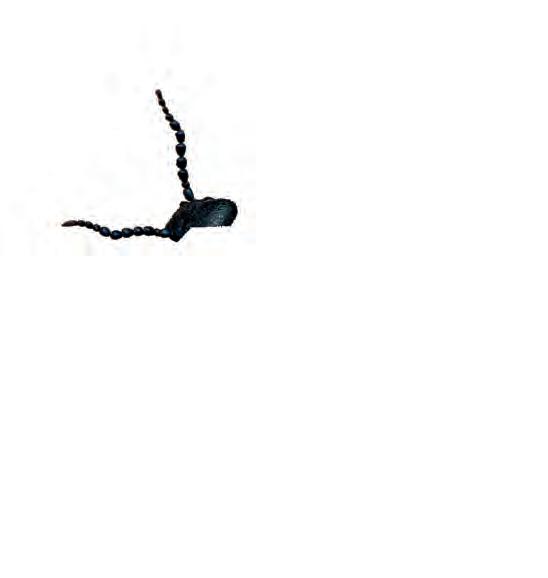

As summer warms our world, and we head towards the longest day of the year, it’s the perfect time to head outdoors and embrace your inner wild child for the biggest nature challenge in the UK.
The Wildlife Trusts’ 30 Days Wild campaign – encouraging everyone to do one wild thing every day through the month of June – is already in full swing.
You could help wildlife in your back yard; learn something new about a strange and wonderful creature; get arty with natural materials; or spend a day enjoying nature under Norfolk’s beautiful big skies. Whatever you do, research has shown it will be good for your health and wellbeing.
30 Days Wild is for people of all ages and from all backgrounds. From mums, dads and kids to schools and care homes, participants come from all walks of life. Two million people have taken part since 2015 and our annual nature challenge continues to grow every year.

Supporters completed over 16 million acts of wildness last year.










If you haven’t already signed up, it’s not too late. Get in touch and we will send you ideas and resources to help you rewild your world this June: wildlifetrusts.org/30dayswild
The most popular activities included wildlife-watching, eating outdoors, planting wildflower seeds and listening to birdsong







A potential problem led to a good solution when the Broads Authority (BA) and Norfolk Wildlife Trust worked together at NWT Martham Broad. To ensure the river remained navigable, BA needed to dredge river-bed silt at various points along the Thurne, including the area where it dissects Martham’s North and South Broads.
The crystal-clear water of NWT Martham Broad is important for the variety and rarity of its aquatic plants. To preserve water quality by preventing silt escaping, the bucket of the dredging digger was

lowered within a floating guard with a rubberised skirt dropping to the riverbed. As an added precaution, a long rubber skirt was strung across the entrance of the North Broad.
Finding appropriate places to deposit dredged silt can be a problem. However, on this occasion, the silt was collected in a barge and used to fill an area of reedbed nearby that had suffered erosion over several years. NWT staff and volunteers then installed floating coir matting to stabilise the silt and give support to the reed plugs they planted within it.
Participants agreed their favourite activities were those that directly helped nature and those that expanded their knowledge of the natural world.
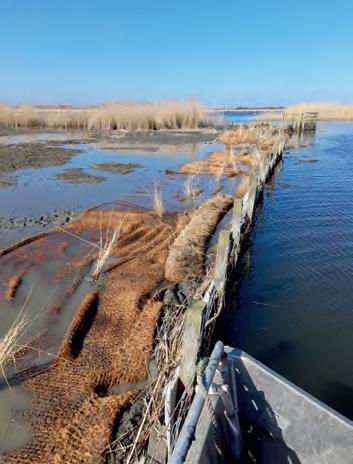
Just 100 years ago Britian’s cereal fields supported an array of annual wildflowers. In the 20th century, the advent of modern farming almost eradicated most of these unwanted flowers that many farmers’ regarded as weeds and many species are now vulnerable to nationwide extinction. The Arable Plant Reserve, next to NWT Weeting Heath, has been managed for many of Breckland’s rarest annual plants since 1970 and has recently been purchased by NWT.
The reserve was established on land owned by the Parrott family when Cambridge University student Anne Jones approached Christopher Cadbury, who was an ardent advocate for Norfolk’s wildlife. Anne’s aspiration was to create habitat in the Norfolk Brecks
Rush Hills and Swim Coots, the two wader scrapes on the south side of Hickling Broad, are important stopoff points in spring and autumn for migrating waders including blacktailed godwits, ruffs, dunlins and little stints. In summer these bodies of water are important feeding sites, used by great and little egrets, spoonbills, avocets and redshanks.
The water level is managed to benefit the widest range of birds over the year. Shallow water and areas of exposed mud are provided for waders in summer, while deeper water is maintained for wildfowl in winter. Water management is achieved using two drop-board sluices and occasionally pumps.
Senior Reserves Assistant, Robert Smith, says, ‘We work hard to manage water so it is at the right level for each season. To judge when to allow water on or off the scrapes, we have to anticipate rainfall and monitor the height of the Broad. The number and variety of birds using the scrapes is impressive and plenty of rare birds
to preserve the rapidly disappearing annual flora of arable fields.
Christopher Cadbury approached the Parrott family who farmed at Weeting, and Norman Parrott began to cultivate 10 acres of his land as the Arable Plant Reserve we see today. The delicate management of this fantastic site was continued by Norman’s son, Richard, at his own expense. Richard has now passed the baton to NWT. We will continue to cultivate this unique reserve for its rare annual plants.
James Symonds, Warden at NWT Weeting Heath, is delighted by the acquisition: ‘The sheer abundance of flowers among the crop on the Arable Plant Reserve makes it immediately clear how special it is. There are lots of
The Arable Plant Reserve supports threatened plants including fingered speedwell


threatened species — a good example is fingered speedwell. This tiny plant, with beautiful deep blue flowers and distinctly lobed leaves, is so rare that this one field probably supports 99% of the British population.’
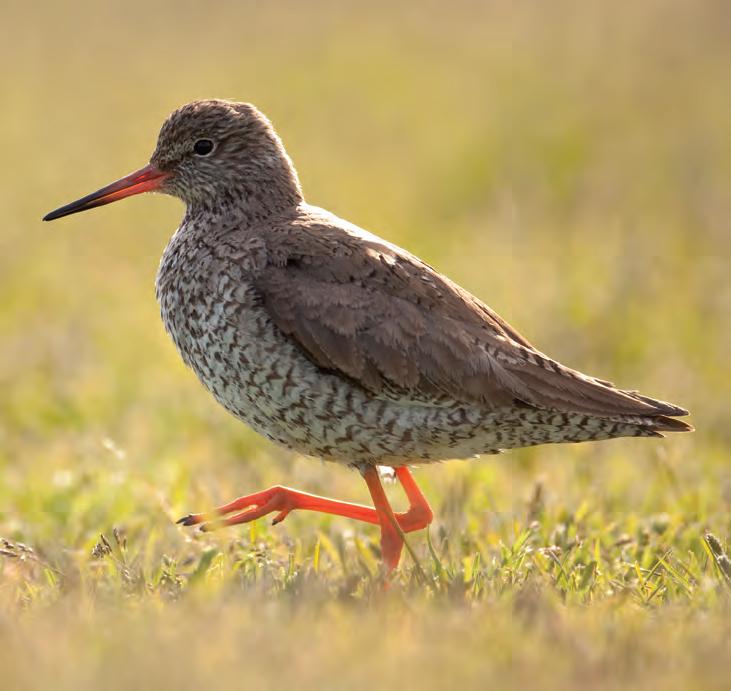
have been recorded on them. In the shimmering height of summer, you could be forgiven for thinking it is the Camargue’.
Scrapes at Hickling Broad are important feeding sites for birds such as redshanks
Hides overlooking Rush Hills and Swim Coots are accessible from NWT boat trips. Rush Hills can also be viewed from a public hide on the Weavers’ Way.
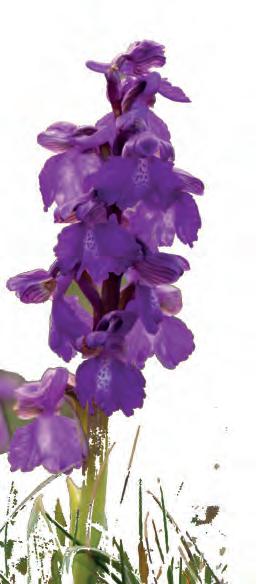
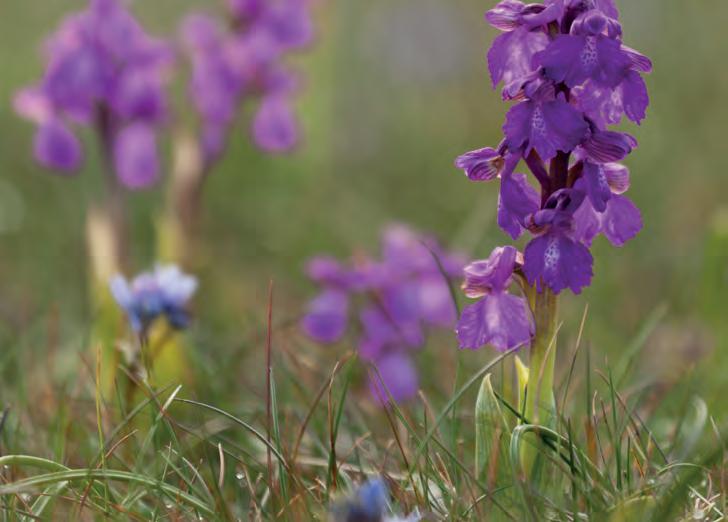
This year’s Annual General Meeting will take place online. Further details will be set out on our website, social media and AGM mailing. Please contact Marion Riches on 01603 625540 or email: ceoadmin@norfolkwildlifetrust.org.uk if you have any queries.
Beetley Meadows and Hoe Rough support five species of orchid, including green-winged orchid
In summer 2020, thanks to a generous legacy and support from Anglian Water’s Flourishing Environment Fund and the Banister Charitable Trust, NWT purchased Beetley Meadows, near Dereham. This was an important acquisition, as the site lies across the river from our existing Hoe Rough reserve. These additional 11 hectares nearly double the land under our protection here.
The reserves are a rich mosaic of habitats, and parts of them are already classified as Sites of Special Scientific Interest, for their plants and insects. The two sites are separated by the River Whitewater, a crystal-clear chalk tributary of the Wensum. With only around 200 chalk streams in existence globally, 85% of them in England, Norfolk’s many examples are internationally important. The Whitewater is home to a significant population of native brown trout. It is also important for many insects and for aquatic plants including river water crowfoot.
NWT Nature Conservation Manager Steve Collin said: ‘Beetley Meadows and Hoe Rough are fine examples of unspoiled wet meadows, with an exceptional range of grassland plants.
They support five species of orchids: green-winged, early marsh, southern marsh, common spotted and common twayblade. Among the best tools for keeping the sites in optimal condition is traditional grazing with cattle, but the separation of the two reserves by the river has proved awkward for graziers.’
Thanks to funding from Biffa Award through the Landfill Communities Fund, a bridge will soon be built between the reserves, making it easier to move cattle and improving the access for visitors. In addition, new livestock fencing will be erected and several adder hibernacula constructed, while some areas of grassland will be scraped to create better conditions for orchids. Brushwood faggots are being placed at selected points in the river to stimulate faster flow. This will keep the gravel bed exposed, favouring brown trout and other chalk-stream specialists. The over-arching aim is to restore ecological connectivity along the river valley.
NWT Beetley Meadows and Hoe Rough are part of the Wendling Beck Environment Project, a habitat creation, nature recovery and regenerative farming initiative: wendlingbeck.org
The floating NWT Visitor Centre at Ranworth Broad is a popular attraction for visitors from spring to autumn. The short stroll along the boardwalk is a fascinating journey through various Broadland habitats, from the mighty oak that stands at the entrance, through alder and willow carr, and reeddominated fen, to the Visitor Centre and the open water of the Broad.
The boardwalk takes visitors across centuries of peat accumulation on the margin of the Broad. This soft, wet peat is over five metres thick in places, meaning constant effort is required to keep the boardwalk stable and safe. This spring, staff have been busy replacing sections of the boardwalk before the summer season.

For National Marine Week, from 24 July to 8 August, we will again be celebrating all things marine.
There is nowhere better to appreciate our incredible UK coast and its wildlife than Norfolk. From shingle banks and sand dunes to Europe’s only chalk reef, Norfolk’s marine wildlife is second to none. However, much like our county’s land-based wildlife, it is in urgent need of protection.
With an ever greater range of pressures on our marine wildlife, there are challenging times ahead, but healthy seas are part of our own life-support system. We are committed to being part of the discussion and the solutions required to ensure space for nature on the Norfolk coast.
In light of this, we are delighted to host the Marine Conservation for Norfolk Action Group (MCNAG) conference, taking place on Saturday 6 and Sunday 7 August during National Marine Week. Join us at NWT Cley Marshes for two days of talks, panel discussions and activities as we celebrate the importance of the Norfolk coast for wildlife and people, explore the challenges facing our marine environment, and discuss how we can work together to protect it.
The event is aimed at everyone from marine enthusiasts and conservationists
to those who simply enjoy the Norfolk coast, no matter your area of expertise or level of knowledge. NWT will be running family activities on the Sunday. For the full programme, and to book, visit www.mcnag.org
We’ve got lots of events planned for National Marine Week. For the full programme and to book, visit norfolkwildlifetrust.org.uk

The Cromer chalk reef is millions of years old. At 20 miles long and found 20m below the surface, it is the only one of its kind in Europe.
Like an underwater city, it has a busy centre and sprawling suburbs. It is home to the famous Cromer crab and countless wonderful creatures including greater pipe fish, small spider-crab, sea toad and plumose anemone.
In 2016 the Cromer chalk reef was the first area of our regional coast designated as a Marine Conservation Zone in recognition of its importance for wildlife.

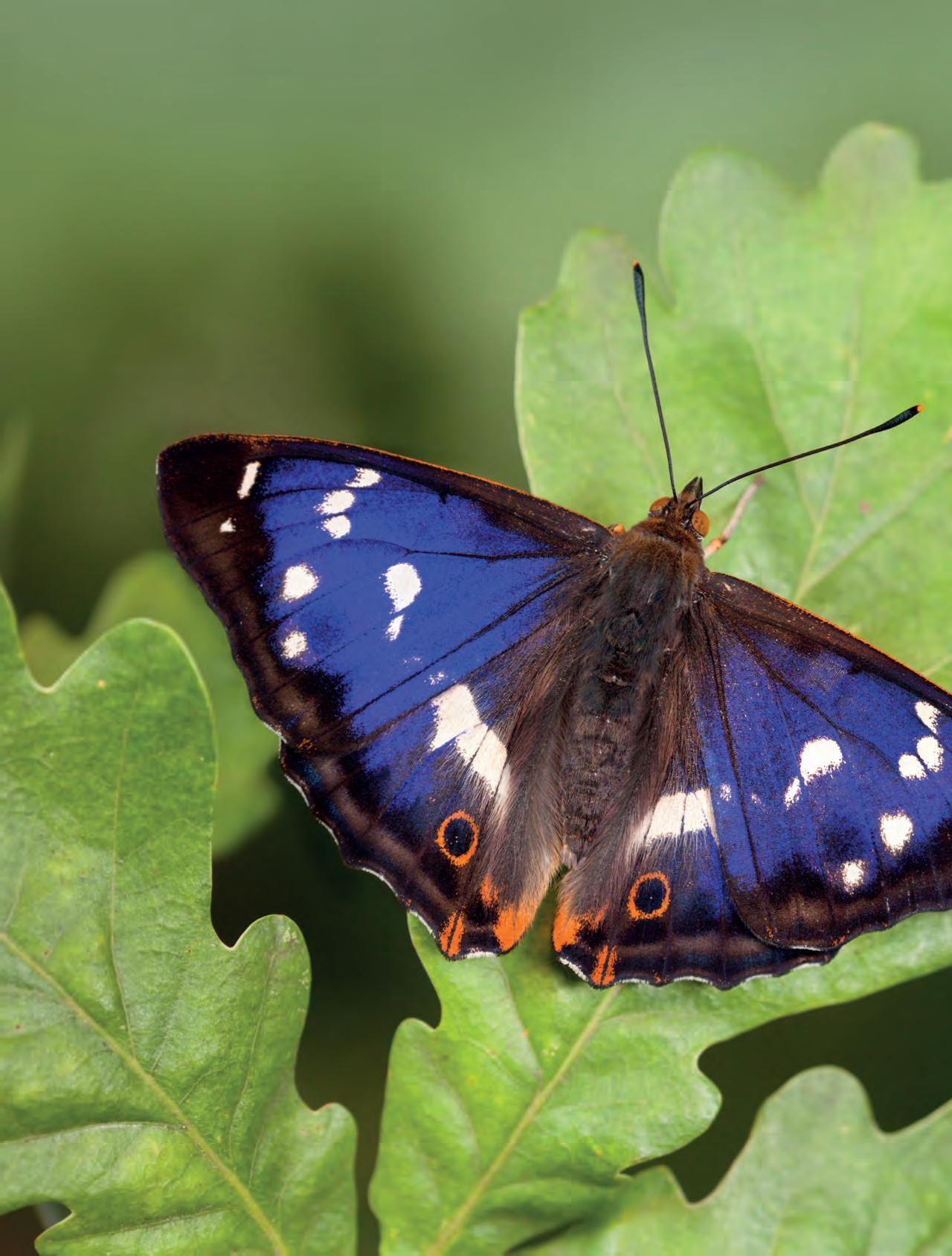

Historical records suggest the swallowtail butterfly was once known as the queen. Despite losing this title, the swallowtail has always reigned supreme over Norfolk. In the summer of 2017, however, its eminence was usurped by a higher-ranking monarch, the purple emperor. After an absence of over forty years, this magnificent butterfly has returned to its former realm. The purple emperor has never been numerous or widespread but, prior to its disappearance in the 1970s, it did have a strong foothold in Norfolk. Even up until the 1950s, it was recorded from most suitable woods across the county, including NWT Foxley Wood, a site to which it has now returned.
Since ancient times, purple has been a chosen colour for royalty and the male emperor doesn’t disappoint. Its iridescent wings shimmer as the
butterfly skips through dappled sunlight, switching back and forth from brown to electric amethyst.
Despite being Britain’s second largest butterfly, the purple emperor is not easy to find. It never nectars on flowers and spends most of the day sitting high up in the oak canopy, feeding idly on aphid honeydew. However, males regularly patrol nearby clearings, looking for passing females. Eggs are laid on grey willow, and the resulting, somewhat slug-shaped caterpillars are green with yellow stripes.
With increasing sightings across Norfolk, a visit to a mature wood in July or August could result in you discovering this magnificent butterfly. With luck, this won’t prove a purple patch, but the start of a long-term colonisation by this glorious sovereign.

Learn about this ancient wood and its purple emperors on page 36
With an abundance of wildlife, fresh air and unrivalled views, the North Norfolk coast makes for a perfect day out. But, as we head to Norfolk’s beautiful beaches in the summer, we must spare a thought for the special wildlife with which we share the coast.
On beaches at coastal sites including NWT Holme Dunes, resident birds such as oystercatchers and ringed plovers begin settling down in spring, in readiness to raise their families. Little terns soon arrive to do the same, though these incredible birds have first made the long journey to Norfolk from West Africa!
A modest collection of stones and sand suffices as a nest for these beach specialists. These beautiful birds are consequently extremely vulnerable in
At NWT Holme Dunes, ground-nesting birds, such as ringed plovers (below), are extremely vulnerable to disturbance
spring and summer to disturbance by humans and dogs. The camouflaged eggs of all three species are easily trampled and pairs that are disturbed readily abandon their nests.
In the last 35 years, the population of ringed plovers in Norfolk has declined by a shocking 79 per cent, with just 123 pairs recorded in 2018. Oystercatcher numbers are also dropping, seeing them join the little tern on the amber list of conservation concern. With almost half of the UK population of little terns attempting to nest on beaches here in 2021, Norfolk is the most important county for this threatened bird. We have a special responsibility to protect it.
Thanks to funding from the Borough Council of King’s Lynn and West Norfolk



Habitats Monitoring and Mitigation (HMM) Fund, and the ENDURE sand dunes project led by Norfolk County Council, in recent years we have employed a summer warden at Holme, to patrol the beach, protect breeding sites and surrounding dunes, engage with visitors and monitor the activity of these three vulnerable species. In 2021, support from CleySpy and Birds on the Brink also provided us with a spotting scope for visitor activities and enabled us to put up electric fencing to keep out ground predators.
There will once again be a dedicated warden on the beach at Holme this summer. Please stop for a chat when visiting, to learn about these special birds and how you can help them on your visits to the Norfolk coast.
By following these three simple steps, you can be part of the difference between a successful breeding season and losing these special birds forever:
Stay away from fenced-off breeding areas
Follow directions on signs
Keep dogs on a lead when asked to do so
This June and July we’re asking for your opinions on Holme Beach and its users, in particular dog walkers, so that we can work together to better protect the rare and vulnerable wildlife that makes a home at Holme. To take part in our online survey, please visit: norfolkwildlifetrust.org.uk/holmedogsurvey












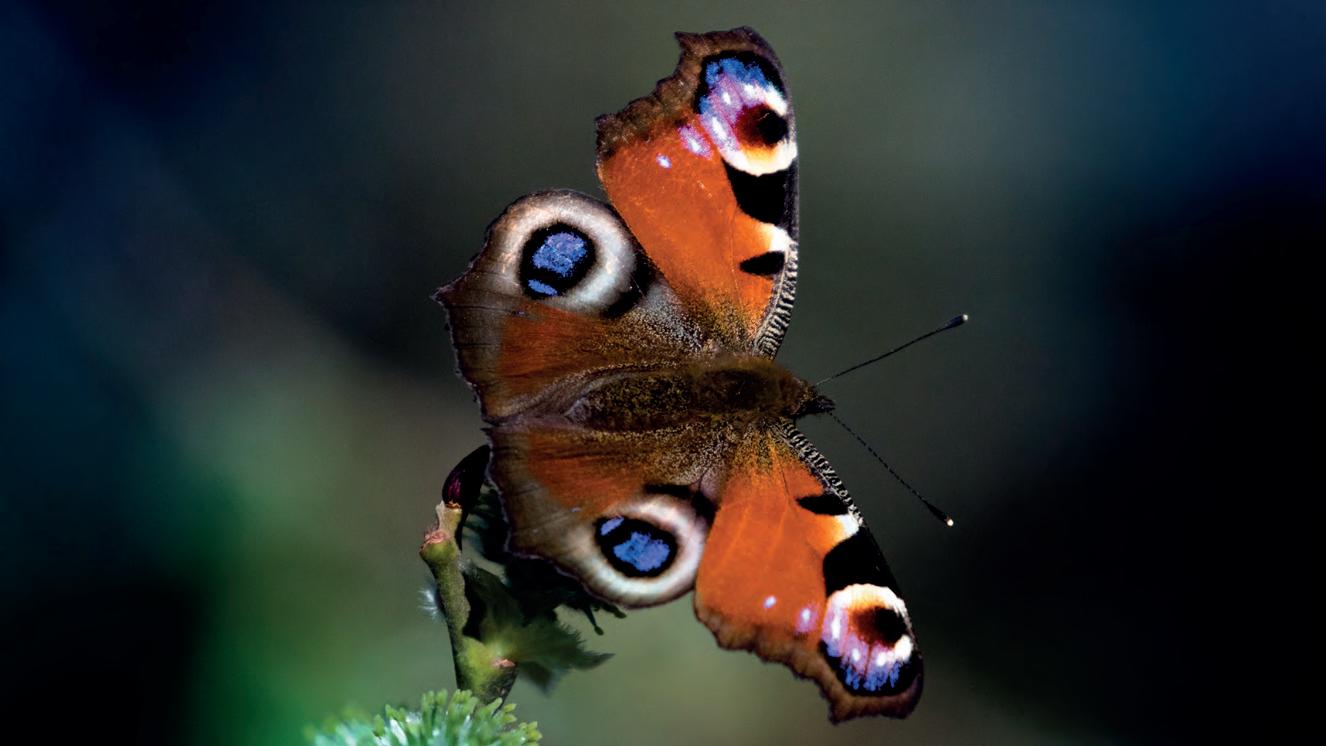



There is something about the rich mahogany front of a red-breasted goose which makes the bird more aesthetically pleasing than your average goose! These birds will be well known to many of you as regular fixtures in wildfowl collections, such as the one by Blakeney Quay. In real life, they breed in northern Siberia and winter around the north-west of the Black Sea, in Romania and Ukraine. If it is particularly cold, they can continue heading south to Bulgaria and occasionally Greece. Higher numbers are also starting to be recorded in Hungary; so perhaps they could become more regular here if their westward wintering spread continues.
Almost every year, the odd bird mixes with our regular wintering darkbellied brent geese, which also breed in Siberia, and accompanies them to the UK. This winter two stayed for a while in Essex but, from the beginning of January, one of them came north to NWT Cley Marshes. Here, it spent the next three months commuting with the
dark-bellied brent geese between Cley, Blakeney and Salthouse. These geese are savvy enough to be aware that on the reserve there are no great threats, other than the odd scary marsh harrier or peregrine, so they happily munch away on the grass, sometimes within yards of admiring humans.
This winter, certain fields and rough habitats held a bountiful supply of voles. You could tell not by carrying out a live rodent-trapping survey, but just by witnessing the number of short-eared owls that survived the winter hunting them. There were at least four (probably more) at Winterton Dunes NNR and up to five around St Benet’s Abbey. At Winterton, this was despite the number of people criss-crossing the dunes and the unbelievable number of dogs, off leads, gallivanting over the reserve.
This page: Red-brested goose
Opposite page: Garganey (left), Eurasian eagle owl (right)
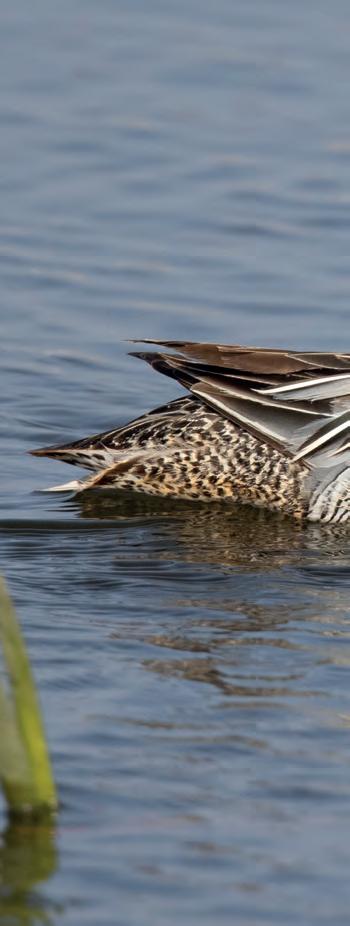


‘Never have I seen garganey at such close range and seemingly without a worry in the world. What a joy!’
These pressures seemed to have no impact on the owls, in that they stayed for the whole winter. In fact, many people who might not normally pay much attention to birds were captivated by the owls’ buoyant butterfly-like flight and their generally confiding nature, which meant they would often remain perched as people walked by.
Nearby, a Eurasian eagle-owl at Ormesby St Margaret and another in Norwich hit the headlines. Although it is theoretically possible for a Eurasian eagle-owl to cross the North Sea from European breeding spots, none has so far been proved to do so. Photographs of these birds showed that both were escapees. The Norwich bird had what looked like a leather strap attached to its leg and the Ormesby bird eventually shook a leg to reveal a ring. It may be possible to determine the origins of birds seen in the future by scientific analysis

of their feathers. So, if you spot one, try to collect a feather.
One of the most exotic-looking of the early birds to come here for the summer is, perhaps surprisingly, a duck. Birdwatchers eagerly hope to find the first garganey of the year, which can often appear as early as February. It’s not as easy as you might think though, as garganey are rare breeding birds in the UK, with just over one hundred pairs. Only five pairs were confirmed breeding in Norfolk in 2019. This gorgeous little duck, similar in size to the Eurasian teal, winters in Africa and Asia and breeds in Europe and Siberia. This year, unusually high numbers appeared in southern Spain, and with the warm southerly zephyrs in March, greater than average numbers turned up in the UK too. Plenty were seen in Norfolk, but the three pairs at NWT Cley Marshes took the biscuit. They seemed completely
Submit your own wildlife sightings and take part in our spotter survey, see page 34
oblivious to their admirers gawping at them feet away from the slats of the hides. Never have I seen garganey at such close range and seemingly without a worry in the world. What a joy!
The article and photographs on this page are by Robin Chittenden, ‘the voice of Birdline East Anglia’. Anyone can listen to the latest bird sightings by phoning 09068 700245 Calls cost 65p per minute plus your telephone company access charge. For enquiries please call 07941 333970.
You can see more of Robin’s bird & wildlife photographs at birdlineeastanglia.co.uk



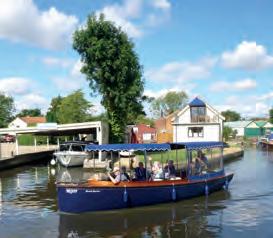
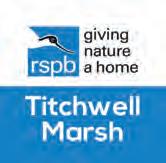




















Planting woodland is a fantastic legacy for the future and people across the UK are currently gearing up for tree-planting as part of the Queen’s Green Canopy initiative, created to mark Her Majesty’s Platinum Jubilee this year.

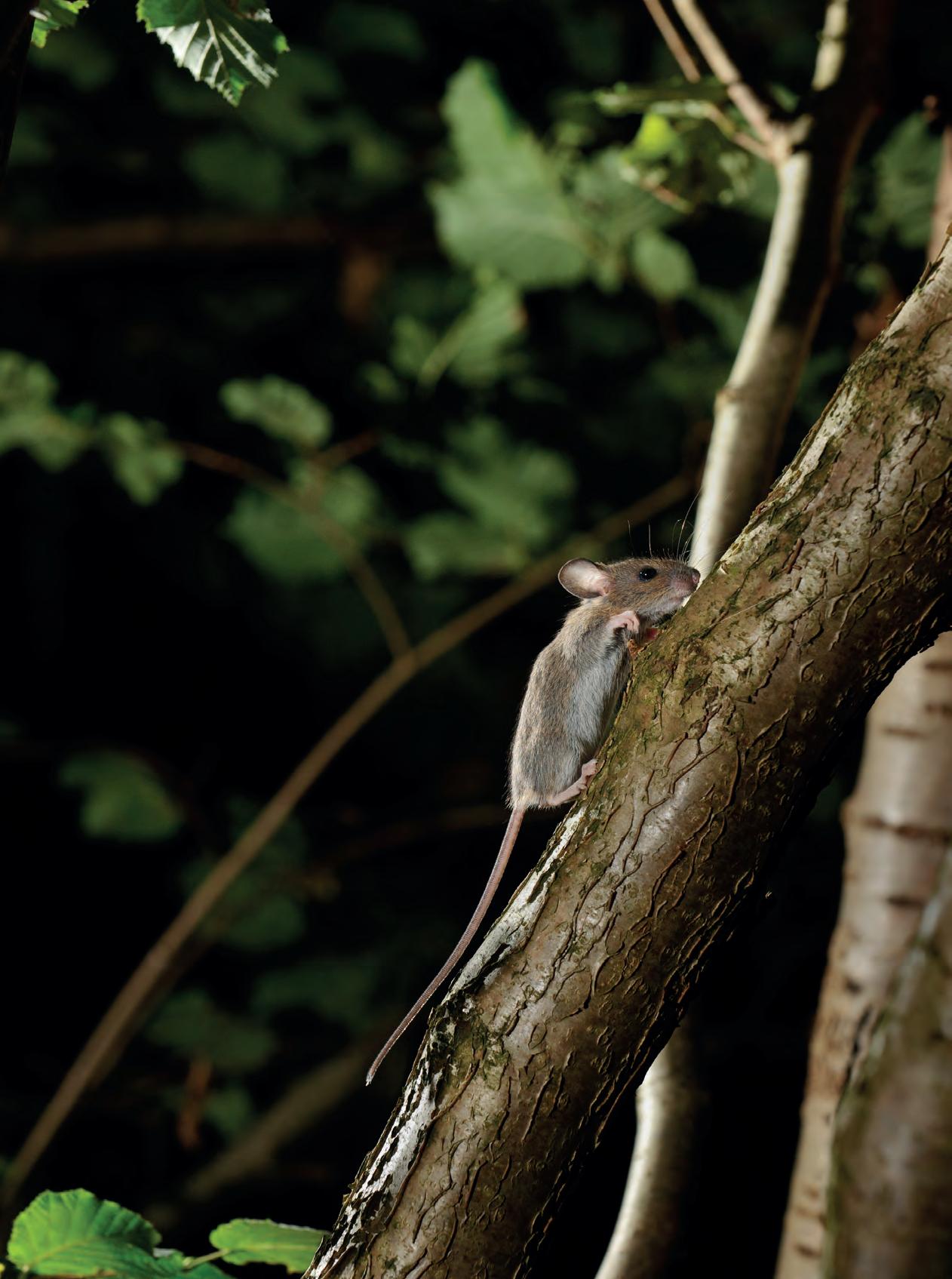
Trees’ ability to store carbon is often an incentive for tree planting and, with careful planning, new woods can also be enjoyed by people and wildlife for decades to come.
Whatever the scale of your planting, from a tree in your garden to a wood on a farm, NWT recommends the following tips:
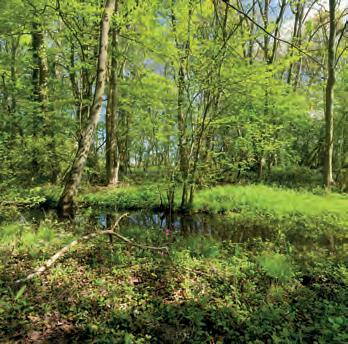
1 Start by finding out what you have already: different soil types suit different species of trees and existing wildlife features such as meadows, ponds and fens need to be considered too. Information on existing habitats is available from NBIS nbis.org.uk The right tree in the right place is an important rule of thumb for woodland creation.
2 Draw up a design that takes account of the site’s wildlife features and builds in some new ones. If you walk around an old woodland, you will spot a varied structure – maybe rides and glades, ponds and ditches, along with old trees, hopefully young trees and also dead trees, both standing and fallen.
All of these provide habitats for wildlife and thinking about how to include them in your wood will help your design. For example, leave plenty of space around ponds, which need sunlight, and create a design that includes rides and glades if the wood is over about three acres. Wildlife loves variety, so open, sunny areas within woods are a must for butterflies, dragonflies and birds.


3 Select a range of species suited to your soils and drainage. It is a good idea to see what trees grow well nearby, as these will best support local wildlife. With a changing climate in mind, add in a few species that like warm, dry conditions, such as hornbeam, sweet chestnut, wild service and small-leaved lime. Fruit trees, like crab apple or wild pear, will thrive on the woodland edges and provide food for birds and pollinating insects. Shrubs like hawthorn, spindle and guelder rose also provide food and shelter for many wild creatures.
4 Spacing – vary the spacing of tree-planting a little, with some closely planted areas and others that are more open.

5 Create new micro-habitats such as log piles as shelter for invertebrates, along with bird, bat and bee boxes. It will be a long while before the young trees can support these species, so give them a chance from the start.
6 Plan for future management. In a few years, woods may need thinning if the trees are crowded and coppicing of species like hazel and willow will provide low cover for small birds in the future. Coppicing means cutting down a tree to the ground and allowing it regrow.
Finally, don’t be in a hurry. The process of turning land into woodland is slow, but the wildlife you see along the way will be worth it.
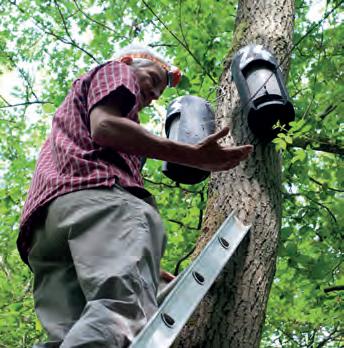
Of course, you don’t need a woodland to get involved. The same guidance broadly applies whether you’re a homeowner hoping to plant a single sapling in your garden or a local council planning a copse for the Queen’s Green Canopy.
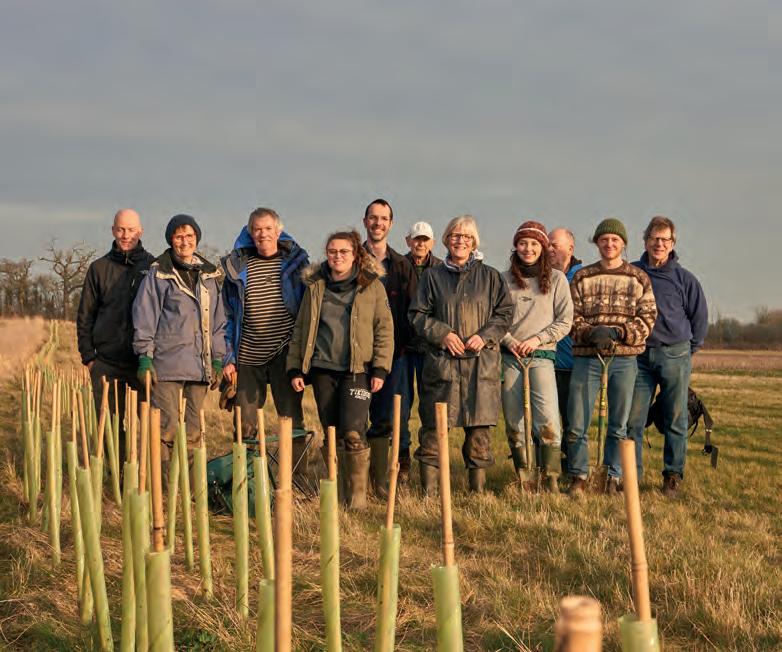
This winter, with the support of a tremendous team of dedicated volunteers with a will to take action for wildlife, we have planted a whopping 6750 saplings – equating to 1.7km of new hedgerow and 0.3km of gap-filling in existing hedgerows. These hedgerows were planted across four farms as part of our Claylands Wilder Connections project.
These new hedgerows will provide food and shelter for wildlife, as well as serving as corridors, connecting patches of existing habitat for the benefit of wild species,
barbastelle bats, barn owls, and a huge range of insects. Connected habitats are fundamental in allowing species to disperse through the landscape and adapt to changes in the environment.
The Claylands project is keen to work with local land managers and is providing a range of opportunities and training for local people – for the latest information, please see the Claylands page on the NWT website.
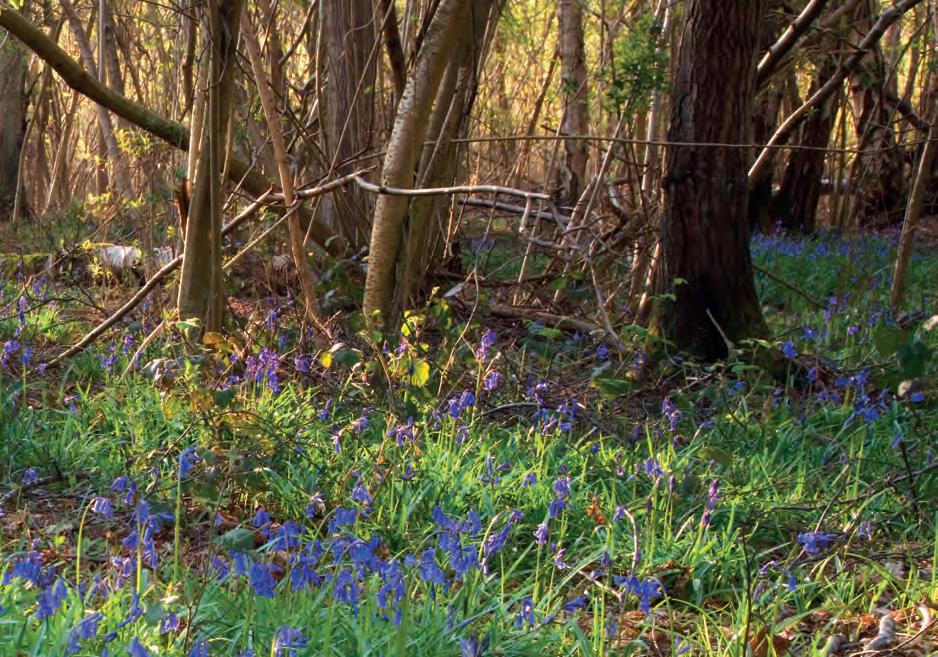



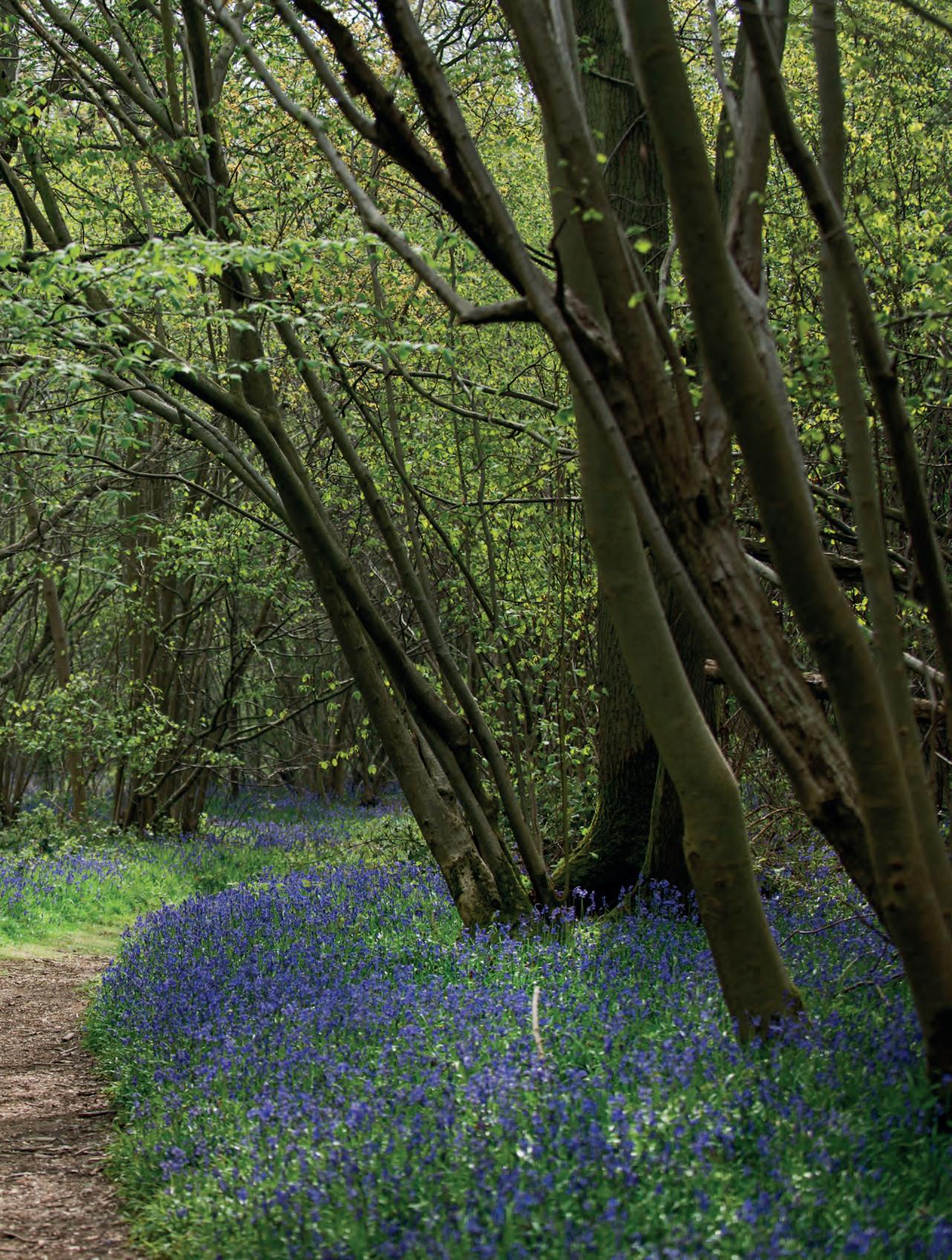


don’t know where to look today. This woodland ride is riotous with the blooms of marsh thistle, black knapweed, wild angelica and meadowsweet. Moving between the flowers, fluttering deliberately as if drunk on nectar, are at least two dozen butterflies. Most of them are huge and vibrant orange, laced with bold black spots and stripes. Underneath, their wings are clouded chalky white and lichen green. These are silver-washed fritillaries.
Silver-washed fritillaries fill me with joy. Extinguished in the middle of the twentieth century, they have recently returned to Norfolk, where they’ve settled in our ancient woods. Here the adults sup from brambles and other woodland wildflowers, and lay their eggs on common dog violets. They are magnificent. Foxley Wood, where I’m standing in a cloud of flowers and butterflies, is magnificent too: another triumph of recovery. In the 1960s three species of fritillaries were known here, plus — most fabled of Britain’s butterflies — the purple emperor. Foxley also held the most precious ancient woodland flora in the county. But it was not to last. The sixties were a time of relentless modernisation, a brave new world of chemicals and technology. Ancient woods were deemed wasted space and a national policy was devised, to convert them to productive conifer plantations.
This was the fate of countless ancient woods, including Foxley.
In preparation for planting conifers, the southern compartments of Foxley Wood were sprayed from the air to kill the native trees with 245T (akin to Agent Orange). The largest oaks were sold for timber but, since there was no demand for firewood then, the majority of the poisoned trees were dragged to pyres and simply burned. Foxley Wood and its priceless wildlife were dying. The splendid purple emperor, like the silver-washed fritillary, became extinct in Norfolk around this time.
But Foxley Wood was to be given a second life. Between 1989 and 1992, Norfolk Wildlife Trust purchased the wood in plots from different members of the family which owned it. At the time, restoring ancient woodland was still a daring new idea. Many conservationists
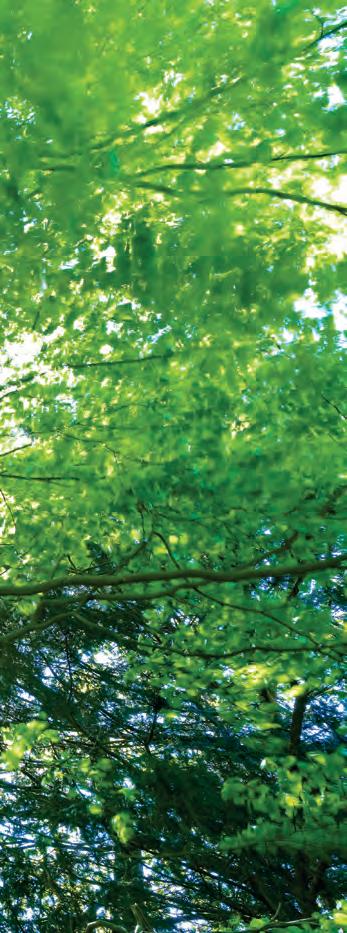


advised establishing a nursery and replanting local native trees; but, having meticulously explored the site, John Milton (who has recently retired from a long career at NWT) knew that Foxley Wood could best regenerate on its own, without additional planting.
Slowly, compartment by compartment, contractors removed non-native, lifesuppressing conifers. As indigenous broad-leaved saplings sprang up to replace them, John’s teams of dedicated volunteers reinstated the regime of rotational coppicing under which the wood had been managed over centuries.
Even as John and his volunteers laboured, Foxley Wood came back to life around them. Willow warblers, garden
‘Silver-washed fritillaries fill me with joy. Extinguished in the middle of the twentieth century, they have recently returned to Norfolk, where they’ve settled in our ancient woods.’
warblers and grasshopper warblers returned to breed in the young coppice, and butterflies filled the newly-opened rides.
The flora was recovering too, as sunlight reached the woodland floor for the first time in thirty years. In the 1870s, the vicar of the nearby village of Lyng had kept a diary, with detailed notes on the wildlife of Foxley Wood. Astonishingly, every woodland wildflower which he identified returned to Foxley following its loving restoration, with some plants, such as adder’s tongue, found in the precise locations he had noted.
Emboldened by our experience at Foxley, in 2009 we undertook the restoration of another lost ancient wood. With a
©CHRISGOMERSALL/2020VISION


generous legacy from Robert’s Woodland Trust, given in memory of Bob Brett, we bought a conifer plantation between Thursford and Little Snoring. Brett’s Wood, as we have named it, is a very different site from Foxley. Much of the wood sits on sandy, Ice Age soils, where removing conifers has allowed lightly wooded heathland to regenerate: home to common ling, heath speedwell, green tiger beetle, silver birch and nightjar. The rest of the wood is damper, with richer soils. Here, the felling of the conifers has revealed an ancient woodland flora, with moschatel, greater stitchwort, common dog violet, early dog violet and sanicle flourishing beneath a canopy of hazel, bird cherry and pedunculate oak.
Brett’s Wood is part of a larger belt of woodland, which includes our precious Thursford Wood, where bluebells, wood sorrel, wood anemone and yellow pimpernel blaze in the understorey of a venerable wood pasture. Together, connected to one another, these two woods — and all the biodiversity they embrace — are better protected against both climate change and shifts in the management of the surrounding landscape.
Increasingly, modern conservationists know how critical connection is. This understanding lies at the heart of Claylands Wilder Connections, our current project in the south of Norfolk. Funded by the Green Recovery Challenge Fund, and with support from Norfolk County Council, the People’s Trust for Endangered Species and the RSPB, we are working with local landowners and communities to recreate wildlife corridors through the landscape. Thanks to pioneering mapping by our colleagues in the GeoData team at Southampton University, we have identified pathways through the Claylands landscape along which meaningful connections for wildlife — through the restoration of ponds, hedges, scrub or strips of meadow — can most readily and effectively be re-established. For woodland
species, this means planting wide native hedges where they have been lost and spinneys to act as woodland stepping stones across the landscape.
At Foxley we are strengthening connections and recreating habitat too. A most welcome and generous donation recently allowed us to purchase Foxley Enclave, a notch of arable land on the southwest flank of Foxley Wood which had been missing from the ancient wood for centuries. Thanks to a partnership with PSH Environmental (see page 44), we are allowing native scrub and woodland wildflowers to recolonise the enclave. Soon we will begin to propagate the rarest species in the wood — including wild service tree and midland thorn — helping them become established in the enclave too.
‘A movement in the canopy of oaks distracts me as I amble along this flowerfilled ride in Foxley Wood today. Almost large enough to be a bird, swooping dramatically, it is a butterfly. ’



Right across the county we are at work, reconnecting woodland where connectivity has been lost. And, for the Platinum Jubilee of Her Majesty The Queen this year, we are honouring our Patron by contributing to the Queen’s Green Canopy, planting trees across the Claylands and restoring threatened black poplars to the River Whitewater at Hoe Rough.
Finally, as we approach our centenary in 2026, we are thrilled to announce the creation of our Woodland Centenary Fund (of which more details will follow in the coming months). Enabled by a very significant donation, the fund will be used to restore and expand native woods across the county, and encourage others to join us in doing the same. We can think of no finer

way to celebrate 100 years of action for Norfolk’s wildlife than affording better protection, wider connection and greater care to our glorious native woods.
A movement in the canopy of oaks distracts me as I amble along this flowerfilled ride in Foxley Wood today. Almost large enough to be a bird, swooping dramatically, it is a butterfly. A bold white
stripe bisects each hindwing. Raising my binoculars, I catch a flash of midnight purple in the summer sun. He’s here again, the purple emperor, reclaiming Foxley as his realm. I smile because, in centuries to come, the trees we plant and scrub we nurture as we celebrate our centenary will shelter Norfolk’s precious woodland wildlife for generations yet unborn to know and love.
WORDS BY RACHEL AND DAVID HOLLIDAY
Wildlife is very important to us. It plays a special part in our lives, not least because we have spent the last 14 years creating our own little pocket of habitat in North Norfolk, which we know as the Wedding Wood.
Don’t get ideas of grandeur: we are of modest means and our wildlife haven is about the size of a football pitch. It was an unproductive corner of a farmer’s field, which we purchased for £3,000 as a gift to ourselves for our wedding. After all what do two 40-somethings who have toasters and kettles want as wedding gifts? Bare rooted native saplings and some wildflower seed mix of course!
And that’s just what we got: 750 or so saplings, mainly hawthorn, wild service, wild cherry, pear, crabapple, dogwood, small-leaved lime and blackthorn. We have been thrilled to watch this patch of land slowly transform from a barren wasteland to a pollen-rich oasis for wildlife which literally buzzes with butterflies and other insects.
In nature’s terms Wedding Wood is still young and its character will no doubt change, but it shows what can be done for wildlife in a small space. For us is a brilliant reminder of our wedding day and it will be the gift that literally keeps on giving.
Which brings us to the point. We recently chose to gift the wood to Norfolk Wildlife Trust in our wills so we can be sure wildlife will always call it home. We can also rest easy that in our own small way we have helped Norfolk’s wildlife.
Gifting in your will is easy, and it doesn’t have to be a Wedding Wood. Even the gift of a few pounds is helpful and your chosen charity gets legacies free of tax.
It’s always worth checking with your charity first, as we did ourselves. We wanted to be sure that NWT understood what the wood meant to us and our wishes for it. We appreciate that things will change, but we have faith that the Trust will always have Norfolk’s wildlife front of mind and that is all the reassurance that we need.
We intend to stick around for quite a few years yet, but since we knew who we wanted to gift the wood to, there seemed little point delaying. Getting your wishes written in your will also
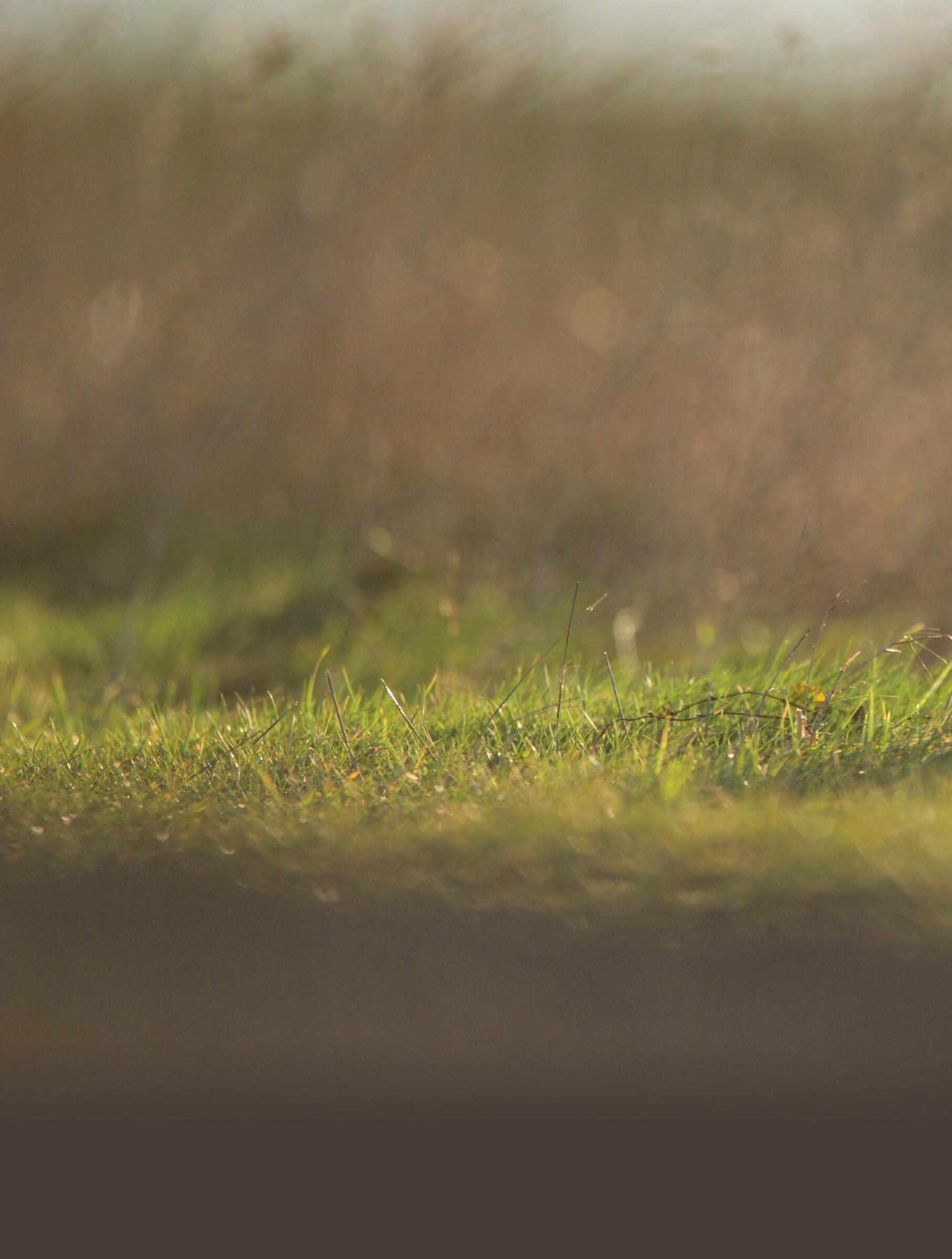
means that they will be honoured in case anything unforeseen happens.
Wildlife plays an important role in our day job too. We are known as Mr and Mrs Moon Gazer, and our microbrewery uses the image of the iconic Norfolk hare on every pint of Moon Gazer ale that we brew.
Why not consider Norfolk Wildlife Trust in your will? We will raise a glass of Moon Gazer to that!
By leaving a gift to Norfolk Wildlife Trust in your will you will help future generations to enjoy our outstanding natural heritage as we do today. To learn more about leaving a gift to Norfolk Wildlife Trust please visit norfolkwildlifetrust.org.uk/legacies or call 01603 625540

‘Wild places can forge lasting memories and hold a special place in people’s hearts.’
Whether it be dappled spring sunshine on bluebells at Foxley Wood or a windswept walk along the East Bank at Cley, wild places can forge lasting memories and hold a special place in people’s hearts. Cley Marshes was one such place for Terry Stevens. His family and friends wanted to mark his fondness
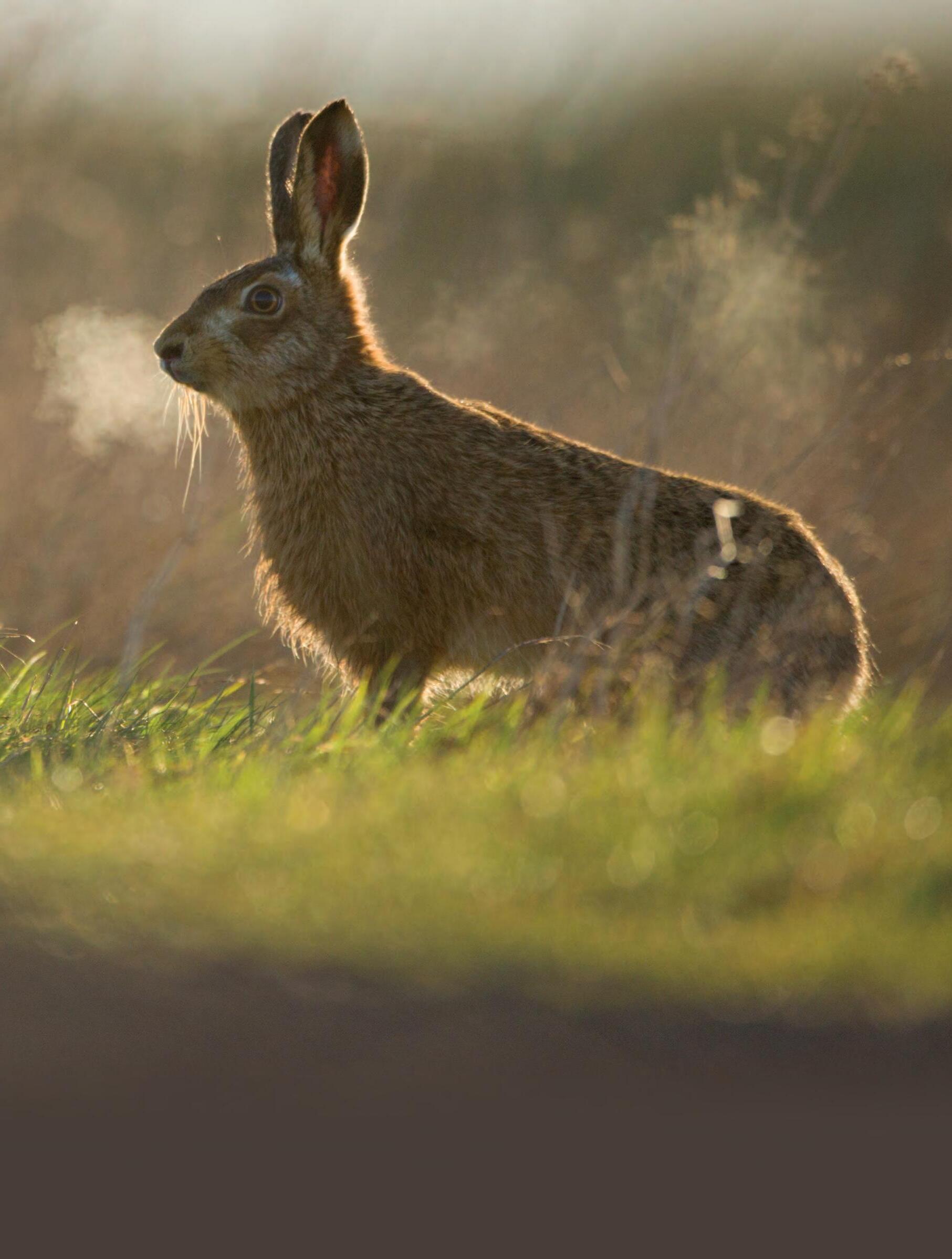
for Cley by donating something useful to the visitor centre in his memory and it was felt his gift should be one of hope, engagement and education. With his family’s agreement, a new screen for the Simon Aspinall Wildlife Education Centre was installed. What might seem an unconventional choice for remembering a loved one is now in daily use, inspiring our many visitors with glorious high-definition images and information on our work for the natural world. It makes a very fitting tribute to a
gentleman who wanted to share his love of nature and Cley Marshes.
Donations in Memory can help us protect wildlife on our nature reserves, or, as with Terry Stevens, help us foster a commitment to nature in the next generation. If you would like to speak to us about making a donation in memory, please contact us on 01603 625540 or visit norfolkwildlifetrust.org.uk/support-us/ ways-you-can-give/legacies/ donations-in-memory
Can you dig it?
Want to green up your neck of the woods? We give away millions of free trees to schools and communities every year.

eligible.




All our profits are donated to the Wildlife Trusts relaxed pace expert leaders small friendly groups natural history holidays
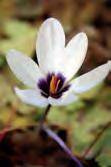
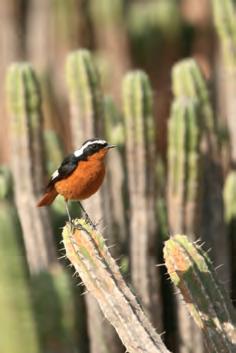
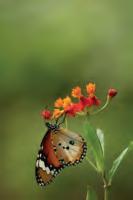


supporting nature conservation since 1988
2022 destinations : rare mammals : summer wildlife
South Africa: the Cape and Karoo : autumn bulbs in Lycia Morocco: autumn migration : Araucarias & alpine flowers : winter wildlife : late autumn wild flowers

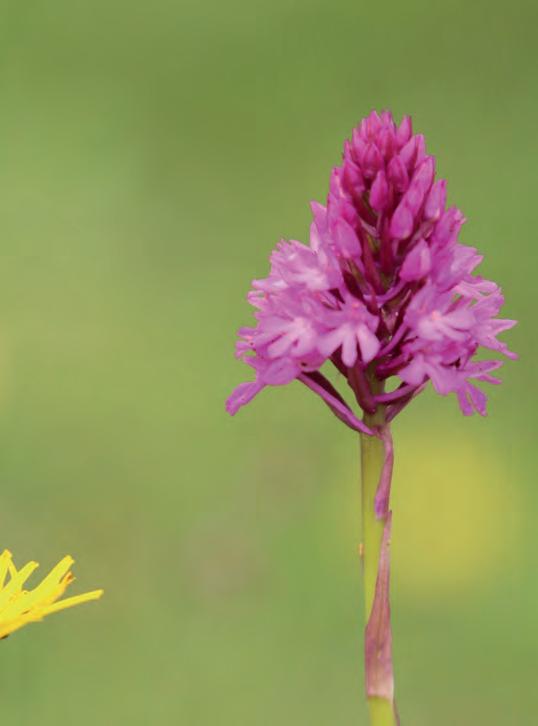
When it comes to delivering better outcomes for clients, we believe financial advice is game changing.
Research from the International Longevity Centre (ILC)* revealed that professional advice offers so much more than just the practical and financial benefits. The research shows that over the space of just 10 years, clients who sought financial advice were, on average, £47,000 better off than those who had taken care of things themselves.
Talk to a Chartered Financial Planner at Smith & Pinching to see how we can help you. Our exploratory review can be over the phone or via video call and is without cost or obligation.
*International Longevity Centre UK - What it’s worth survey, December 2019
We are delighted to announce the winners of our first NWT Young People’s Photography Competition. The competition was open to 13–24-yearolds, who were invited to submit creative photos of Norfolk’s wildlife. Judged by NWT President Patrick Barkham, wildlife photographer David Tipling, and Springwatch’s Lucy
‘Lapwing’ Hodson, over 100 entries were submitted across four categories.
Eliot Lyne, CEO of Norfolk Wildlife Trust, said: ‘Seeing these photos gives me great hope for the future of Norfolk’s nature. It is clear that not only are there talented photographers among younger generations, but that they see our
wildlife for what it is something to be inspired by, to marvel at and to care for.’
Prizes included book bundles from WildSounds & Books, a day out in a hide with wildlife photographer David Tipling, NWT membership, wooden bird boxes and clip-on lenses for use with mobile cameras.

First place, age 13–17 camera –Josh Zinkin, Heron at Holkham
‘I took this photo while visiting Holkham NNR in August last year. I spotted this heron stationary from a good distance away. Using my zoom lens, I captured it in its environment, among the changing shades of the vegetation.’
First place, age 18–24 camera –Daniel Masters, Compass jellyfish at Sheringham Chalk Reef
‘Just after lockdown, when I could finally reconnect with nature, my brother and I decided to snorkel the chalk reef at Sheringham and this compass jellyfish appeared. I love how the light reflects on the jellyfish.’
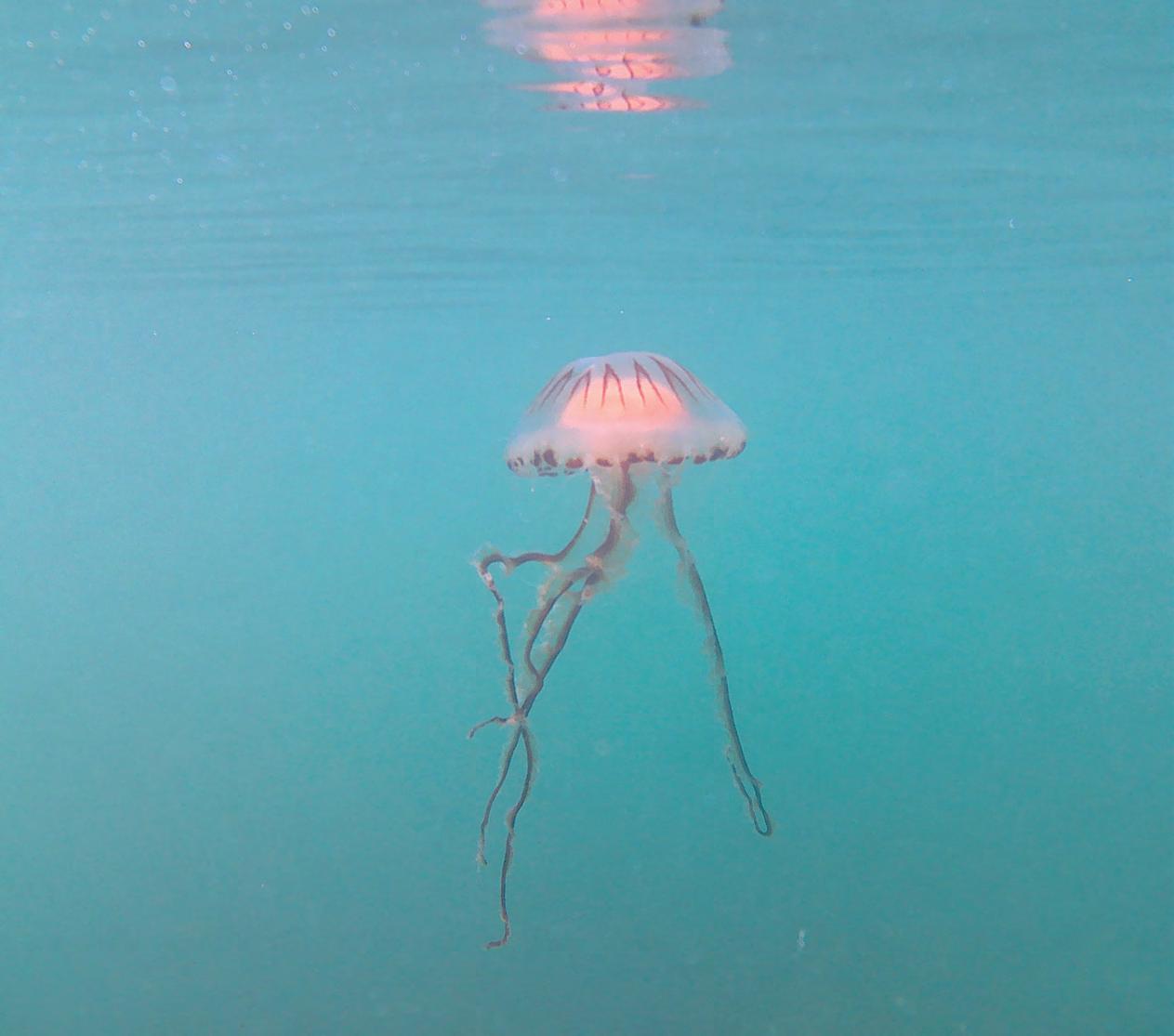
‘It was heartening to see we have some budding young nature photographers in Norfolk, full of talent. Young eyes tend to have a fresh take on how the natural world can be viewed through a camera and the entries did not disappoint. Congratulations to the winners for producing some eye-catching pictures.’
David Tipling, Wildlife Photographer
‘It is difficult but very enjoyable to choose winners from a selection of such stunning photographs. I do think that young people often have a unique and special way of appreciating the natural world, and can refresh the more jaded vision of us older folk! I like how many of these images are of local nature, which we can all enjoy. The heron stalking through the grass is something I love to see but this photo was particularly elegantly composed, and painterly in its subtle colour. All these winners demonstrated not just technical aptitude but creative vision.’
Patrick Barkham, President of Norfolk Wildlife Trust
If you are a young person keen to have a go at nature photography, you can start anywhere – from your back garden or local park, to one of the county’s many nature reserves.
Head to a Norfolk Wildlife Trust reserve for a chance to capture snaps of some of Norfolk’s most special places for wildlife, from ancient woodland and reedbeds to heaths and coastal marshes. www.norfolkwidlifetrust.org.uk

First place, age 13–17 mobile/tablet –Bethany Wilson, Common frog on a school allotment, Old Buckenham
‘I was helping out on my school allotment when this common frog jumped into a growing bed. It was fantastic to show other students and teachers and it brought great joy to the day.’
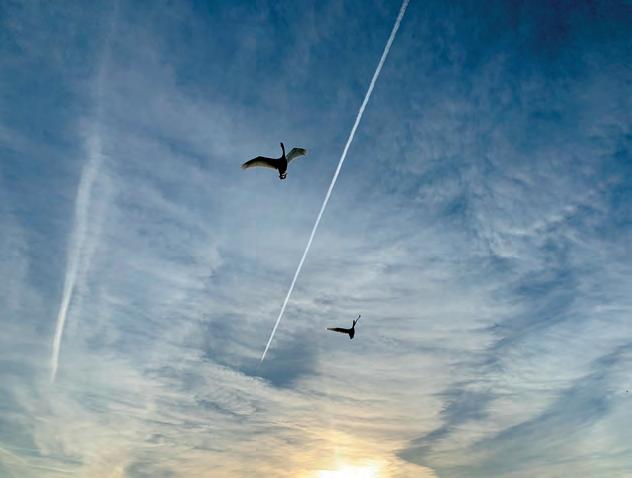
First place, age 18–24 mobile/tablet –Riley Woodhouse, Two mute swans at Kelling
‘The image was taken on my local patch, Kelling water meadows. The swans were resting on the water when they decided to take flight! I had just enough time to snap a photo on my phone. It’s a different perspective: these giant birds framed by the sky, with the aeroplane trail through the centre.’
SECOND PRIZE WINNERS
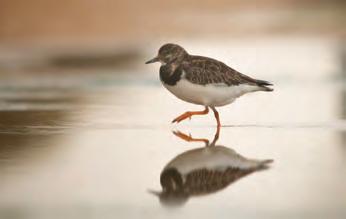
Second place, age 13–17 camera –Henry Keepin, Turnstone and reflection at Waxham

Second place, age 18–24 camera –Martha Glennon, Reed bunting at Buckenham Marshes

Second place, age 13–17 mobile/tablet –Joshua Barrett, Black-headed gulls at Nunnery Lake
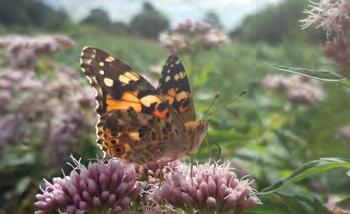
Second place, age 18–24 mobile/tablet –Sophie
See these and more at our Young People’s Photography Competition exhibition at NWT Cley Marshes from 11 to 23 August. See our website for details.
The bright light from the glow-worm, ‘the earth born star’ as Wordsworth aptly described it, is an amazing sight. As you peer into tall grass, what appears like a fibre-optic light shines back. This vivid green light is produced by a female glow-worm. Glowworm, shine-worm, glass-worm, fire-worm – this animal is no worm. It is, in fact, a beetle which belongs to the firefly family, of which over 2,000 species are found in the world.

How to recognise glow-worms
The UK has two species of glow-worm. The European glow-worm is the only one in Norfolk. Its scientific name Lampyris noctiluca roughly translates as ‘nightshining fire lamp’. The egg, larva and male all exhibit luminescence, but it is the glow from the last three tail segments of the female that is usually seen, as she uses her light to attract a mate. The female is a dark brown wingless beetle, measuring up to 25mm. The male looks like a more typical winged beetle. It has a fluttery, almost moth-like flight and large eyes that are used to spot females.
The larva, which hatches from an egg, has six legs at the head end, is black and is made up of 13 body segments, each having two yellow spots on the hind corners. The glow-worm stays in this larval stage for one or two summers and may be seen, especially on a moonless night, glowing faintly for a few seconds at a time.
Where to see glow-worms Gardens, hedgerows, railway embankments, woodland rides, heathlands and cliffs are all possible habitats for glow-worms, particularly in limestone or chalky areas. Although found in a variety of habitats, they prefer areas where there is a patchwork of vegetation, from bare ground to tall grass.
Glow-worm larvae feed mainly on snails and slugs and favour similar habitats to their prey – preferring wet to dry, cold to hot and darkness to light.
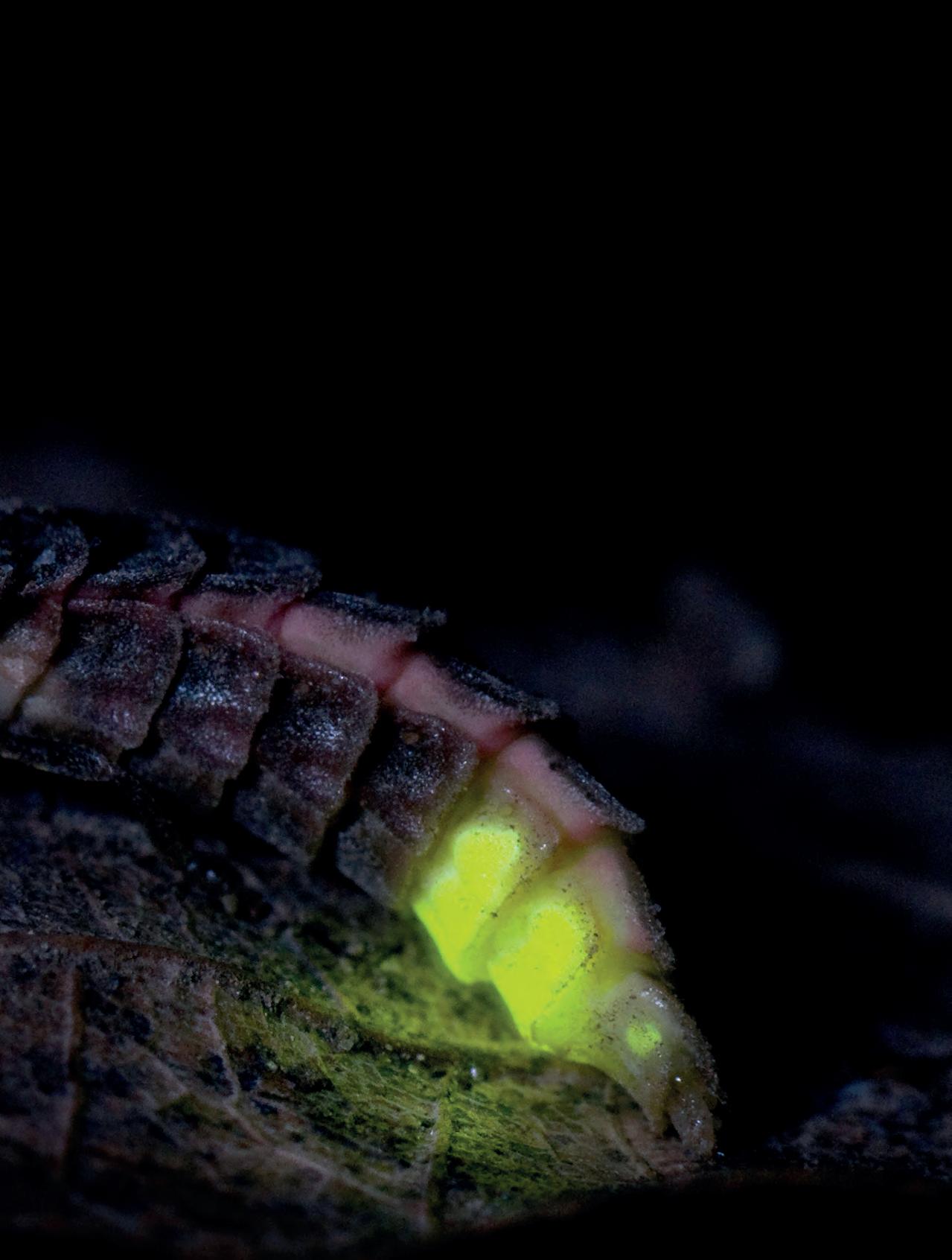
What’s happening to glow-worms?
Since the 1950s, there has been anecdotal evidence suggesting a decline in glowworm populations, not just in Britain, but in the whole of Europe. This may be due to habitat loss, an increase in the use of insecticides, or the fact that there has been an increase in street and house lighting, which distracts male glow-worms from finding the glowing females. Without reliable glow-worm sightings, the decline of this beetle is only speculative. More evidence needs to be collected before a true answer can be given.
How to help glow-worms
If you have glow-worms in your garden, avoid cutting the grass during the glowing season from the beginning of June to the end of August.
Create a glow-worm habitat in your garden – build a log pile as this gives larvae somewhere to hide if it gets too hot and also attracts snails, which the larvae eat.
NWT Foxley Wood, Norfolk’s largest ancient wood, is a special place whatever time of year you visit; but if you are keen to spot wildflowers and insects, why not pay it a visit in summer? In mid-summer, the scented candyfloss flowers of meadowsweet along woodland rides attract hoverflies in large numbers, creating a background hum to a midday walk. Other rides support large stands of common fleabane that attract huge numbers of butterflies (particularly meadow browns and gatekeepers). By late summer the sound of Roesel’s bush-crickets calling in taller vegetation reaches a crescendo on balmy afternoons.
The white admiral is a medium-sized butterfly found in shady woodlands, clearings and rides in late summer. Adults are often found on the flowers of bramble and lay their eggs on honeysuckle leaves, which the caterpillars eat. The white admiral is a black butterfly with distinctive white bands on the wings

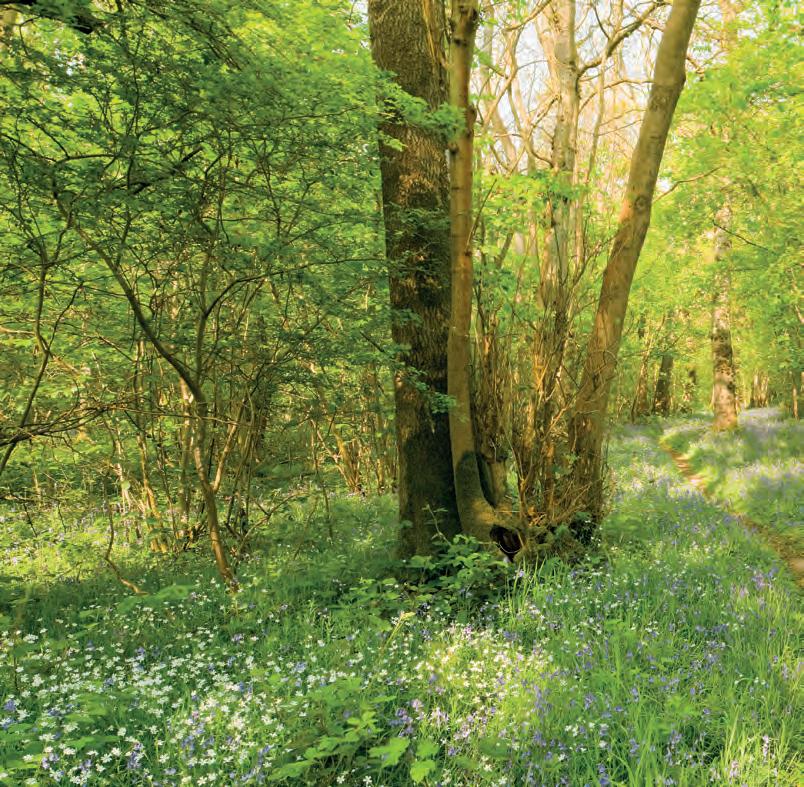
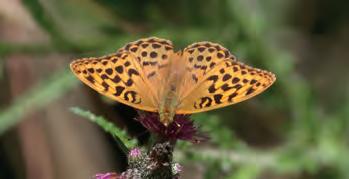
The silver-washed fritillary is a large, pale orange butterfly, so-named for the silver streaks on its underside. Adults can be seen throughout the summer, from late June to the end of August. Silver-washed fritillaries live in broadleaved woods (especially oak woods) and feed on bramble nectar and other flowers in sunny glades and rides. The caterpillars eat violets, particularly common dog-violet.
Midland thorn is a shrub of ancient hedgerows and woodland edges, and is sometimes known as ‘woodland hawthorn’. Midland thorn has shiny, shallow-lobed leaves, and pinkish flowers that smell less strongly than those of common hawthorn. Unlike common hawthorn fruits, which have just one seed, its fruits have two seeds.


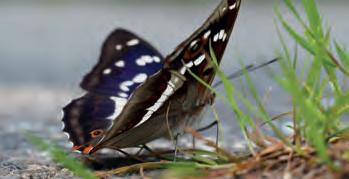
A recent re-colonist of NWT Foxley Wood, this strikingly beautiful butterfly only appears for a short period in late summer. The adult purple emperor spends much of its time in the treetops, feeding on aphid honeydew; so a pair of binoculars is handy if you want to spot this dazzling insect. Males may be seen flying to the ground mid-morning to feed on salts around puddles, on animal droppings, or even on carcasses.
Water avens grows in damp places, such as riversides, wet woodland and damp meadows. The cup-shaped flowers of water avens have dark red sepals surrounding orangeypink petals and a cluster of yellow stamens. They hang delicately on long, purple stems. The jagged, rather bristly leaves are usually found at the base of the stem. Look out for these subtle flowers at the edges of rides.


The bullfinch is a large, plump finch that feeds on buds and fruit in woodlands. Shy and secretive, its melancholy call may be the only indication of its presence in a thicket. Bullfinches usually nest in shrubs, such as hawthorns and blackthorns, making a flimsy nest of twigs and moss.

The garden warbler is a plain-coloured warbler of woodland and tall scrub; habitats it shares with the closely-related and similar-sounding blackcap. Garden warblers are summer visitors from Africa, arriving from April. They breed in low trees and shrubs, building their nests from grasses and lining them with hair.
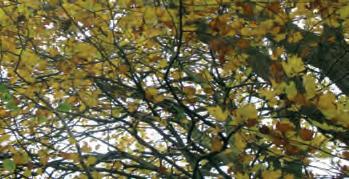
The wild service tree was once widespread, if seldom abundant, in the forests of England and Wales. As ancient woods were cleared, it became rarer and it is now confined to ancient woodlands and hedges. The wild service tree has jagged, palmate leaves (a little like plane leaves), white flowers and small, applelike fruits.
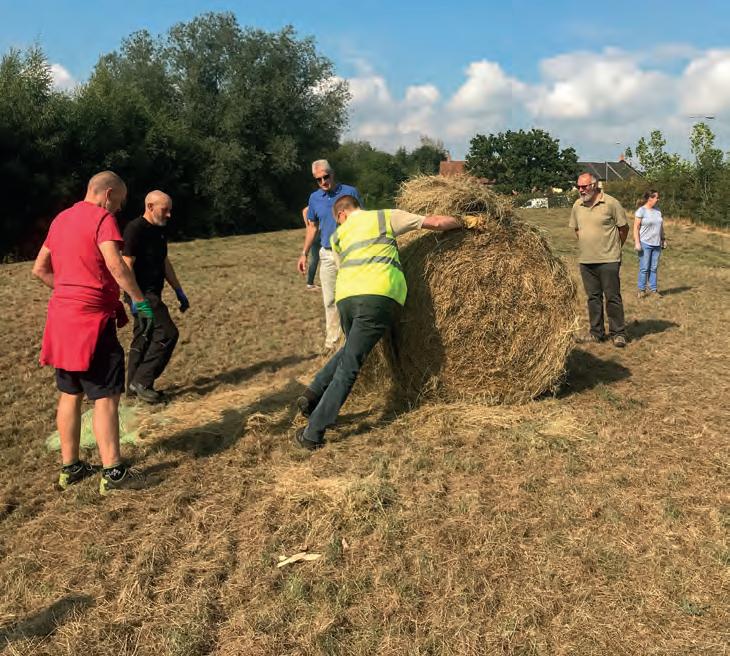
WORDS BY TONY DAVY, CHAIR OF BERGH APTON CONSERVATION TRUST
The Chet Valley B-Line is a community project providing stepping-stones of pollinator-friendly habitat from the source of the River Chet in Poringland to its confluence with the Yare at Hardley. Along the way it takes in Chedgrave Common, Bergh Apton Conservation Trust’s 22-acre nature reserve, and other sites of conservation importance. Although we focus on relatively undisturbed habitats along the watercourse, we promote the conservation of pollinators in the wider catchment. To achieve this, we engage with varied stakeholders to spread good practice to help pollinators: local councils, the agricultural community, businesses, gardeners and conservation bodies.
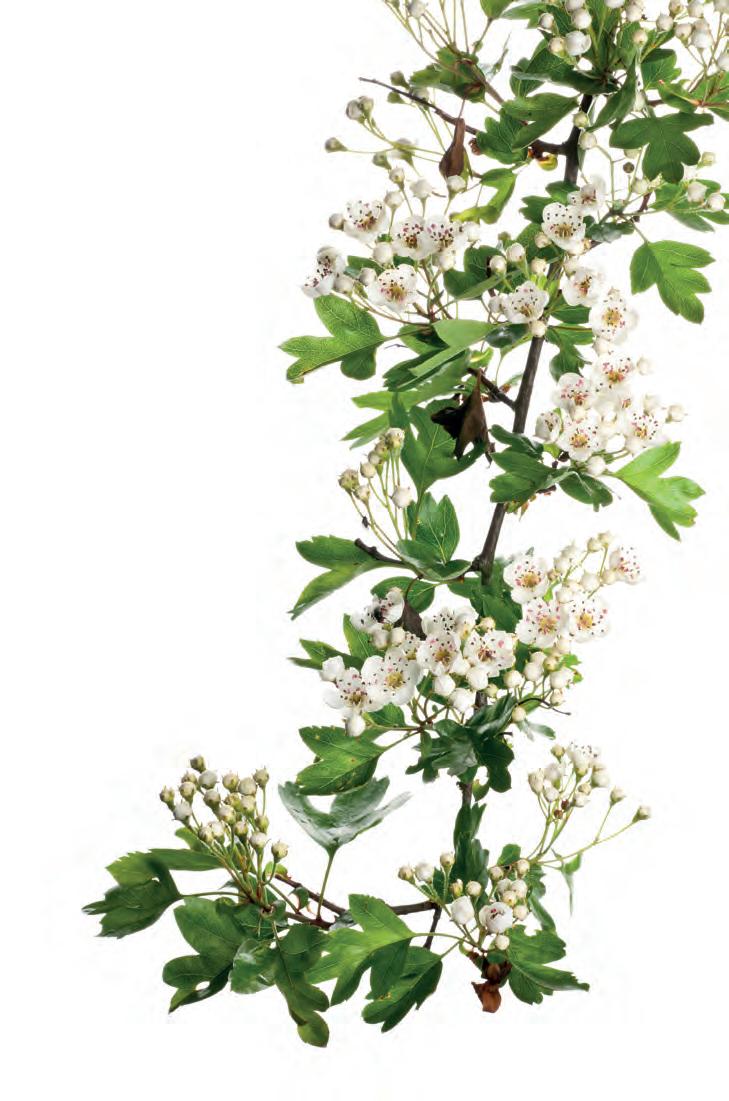

B-Lines were devised by Buglife as a national network of habitat corridors for pollinating insects. Our project, begun in 2017, was the result of a happy coincidence: Buglife alerting us to the scheme, and the proposed acquisition by Poringland Parish Council of 13 acres of community land encompassing the source of the Chet. This attracted the attention of Bergh Apton Conservation Trust (BACT) and South Yare Wildlife Group, and we started lobbying local parish councils and interested parties. The breakthrough came when, with assistance from NWT, BACT was awarded a grant to formalise our activities by the Water, Mills and Marshes project under the auspices of the Broads Authority and the National Lottery Heritage Fund.
The COVID pandemic has forced us to modify our plans, with less emphasis on group activities. Nevertheless, we have mapped almost 100 locations along the valley, also recruiting enthusiastic collaborators. So far, we have planted two pollinator-friendly hedges and distributed quantities of wildflower seed. Perhaps the most significant accolade came in September 2021, when the Norfolk Branch of CPRE declared the Chet Valley B-Line winner in its Biodiversity Champions category. This is just the beginning, however, as pollinators remain desperately in need of help, both locally and globally.
For more information, visit berghaptonconservationtrust.org



Tel: 01328 710810
info@therealaleshop.co.uk www.therealaleshop.co.uk

The shop is located on a family farm growing Award Winning Malting Barley. North Norfolk is steeped in a rich malting and brewing heritage and for over ten years we have built up an unparalleled bond with our local brewers, ensuring the strongest connection between the best malting barley and the finest real ales. This malting barley now also supplies our own new craft brewery, Malt Coast, located here on the farm.
Branthill Farm, Wells-next-the-Sea, Norfolk NR23 1SB
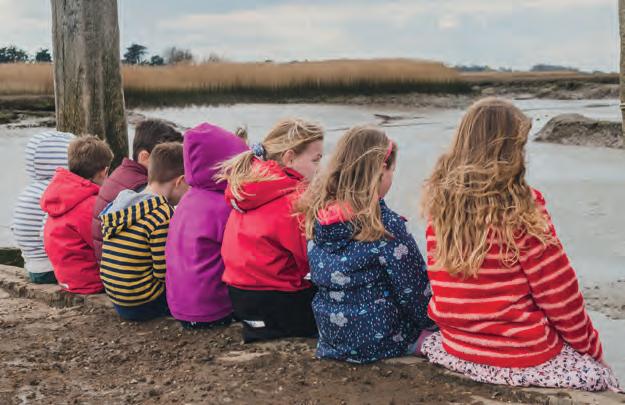


Come together with your community to make more space for nature.
bird boxes and bee
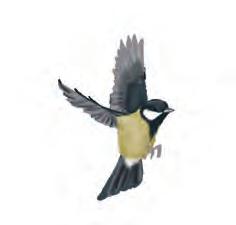
Help wildlife find move into your shared garden, by providing homes! Find that DIY expert in your community and get building.

WORDS BY KATE BRADBURY

Set up a community compost heap
These work really well, helping to reduce waste sent to landfill as well as providing a home for wildlife and compost for mulching.
Many parks and shared spaces have room for a few trees and people love planting them. Set up a crowdfunder to buy a few and plant them together with your neighbours.
A source of water is really important for wildlife, for drinking and bathing. People will be drawn there too if you pop in a bench.

Everyone knows bees are in trouble. Help them by growing herbs like lavender, oregano, rosemary and chives.
Twice a year, I meet up with other members of my local community to plant up and tidy the planters on my local high street. While we work, we chat, discussing planting methods and the best plants for bees. Some of us take clippings home to compost. Many of us end up in the pub afterwards. It’s a lovely thing to do, for the community, the local wildlife and ourselves.
Community gardens and gardening help bring communities together. They can be on virtually any patch of land, from large planters on a main road like the ones I tend, to a park or church grounds (or a section of them). I’ve even seen
community gardens set up in raised beds on a little corner of pavement. The space doesn’t matter; it’s what you do with it that counts.
Whether you grow veg or flowers, or focus on wildlife gardening, there’s plenty of reward to reap from your efforts. You’ll learn more about planting for nature, and can then pass this knowledge on to other members of your community, young and old. As a result, you’ll bring more nature to your doorsteps. If you want to start gardening with your local community, then start with your local park. There may already be a ‘Friends of’ group set up that you
Many people want to grow veg but lack the confidence. Start with easy crops like courgettes, beans and strawberries. Teach people how to sow seeds and raise crops themselves.
can join, but if there isn’t then set one up yourself! You’ll be amazed how many people in your community want to come out and help improve the area, and you’ll make new friends too!
Kate Bradbury is passionate about wildlife-friendly gardening and the author of Wildlife Gardening for Everyone and Everything in association with The Wildlife Trusts.
For more tips on how to make green spaces wilder, visit: wildlifetrusts.org/ take-action-insects

Use a combination of companion planting and wildlife gardening to move away from using chemicals, helping your community learn how to garden in a wildlife-friendly way.

Make log, leaf and stick piles for wildlife to live in, and leave seedheads and long grass over winter. Children will love making (and exploring!) homes for wildlife.
TheOrthoptera are fascinating insects currently represented in Norfolk by 16 species in three families: bushcrickets (Tettigonidae), grasshoppers (Acrididae) and groundhoppers (Tetrigidae). A seventeenth species, the southern oak bush-cricket, has recently appeared in the county.
Bush-crickets lay their eggs singly. Being largely carnivorous, their nymphs must develop alone to avoid sibling cannibalism. Grasshoppers and groundhoppers, which are herbivorous, lay several eggs together in a case, known as a pod. Orthoptera hatch from the egg as vermiform (or worm-like) larvae, in which the first larval nymph is briefly wrapped in a membrane. In grasshoppers, whose eggs are laid in the soil, this membrane is shed as soon as the larva has wriggled like a worm to the surface.

WORDS BY NICK ACHESON, NWT AMBASSADOR
All Orthopteran species undergo what is known as incomplete metamorphosis. Whereas the many insects — including butterflies and beetles — which undergo complete metamorphosis pass through four very different stages — egg, larva, pupa and adult — Orthoptera pass through a series of nymph stages which closely resemble adults. These nymphs grow in size with each ecdysis (or moult).
Mechanical sounds, known as stridulation, are important in the courtship of almost all species, though our two Norfolk groundhoppers (Tetrigidae), which are also our only Orthoptera to overwinter as adults, are not known to produce any sound. Grasshoppers, of which there are six resident species in Norfolk, stridulate by dragging a comb-like series of teeth on the hind femur agains a ridge on the


wing. In seven of our nine bush-crickets, sound is produced by rubbing the wings together. Bush-cricket stridulation is very high-pitched and some species, especially the two Norfolk coneheads, are inaudible to adult humans, though they may be heard with a simple bat detector. Male oak and southern oak bush-crickets produce courtship sounds by drumming with a hind foot on a leaf.
The three Orthopteran families in Norfolk are readily separated. Bushcrickets have long, filamentous antennae which are highly mobile. Females also have prominent ovipositors (for laying eggs) at their rear ends, the shape of which is helpful in identifying species. Male bush crickets have paired appendages on their rear ends, which are known as cerci. These are very large in males of the two oak bush-crickets.
Grasshoppers and groundhoppers have short, stiff, forward-pointing antennae. As adults, groundhoppers can be distinguished from grasshoppers by the fact that the pronotum — the protective roof of the thorax — extends the length of the abdomen. In grasshoppers, the pronotum ends at the rear edge of the thorax. Habitat, stridulation and the pattern on the upper side of the pronotum are all critical in the identification of our six Norfolk grasshoppers.
From May, when the first common green grasshoppers begin to sing from lush grass, until the first frosts of November, which extinguish the last dark bushcrickets, Orthoptera can always be heard in Norfolk. With climate change, new species have recently colonised the south coast of England and may soon join the Orthopteran diversity of our county.



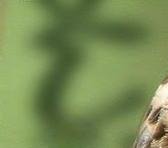



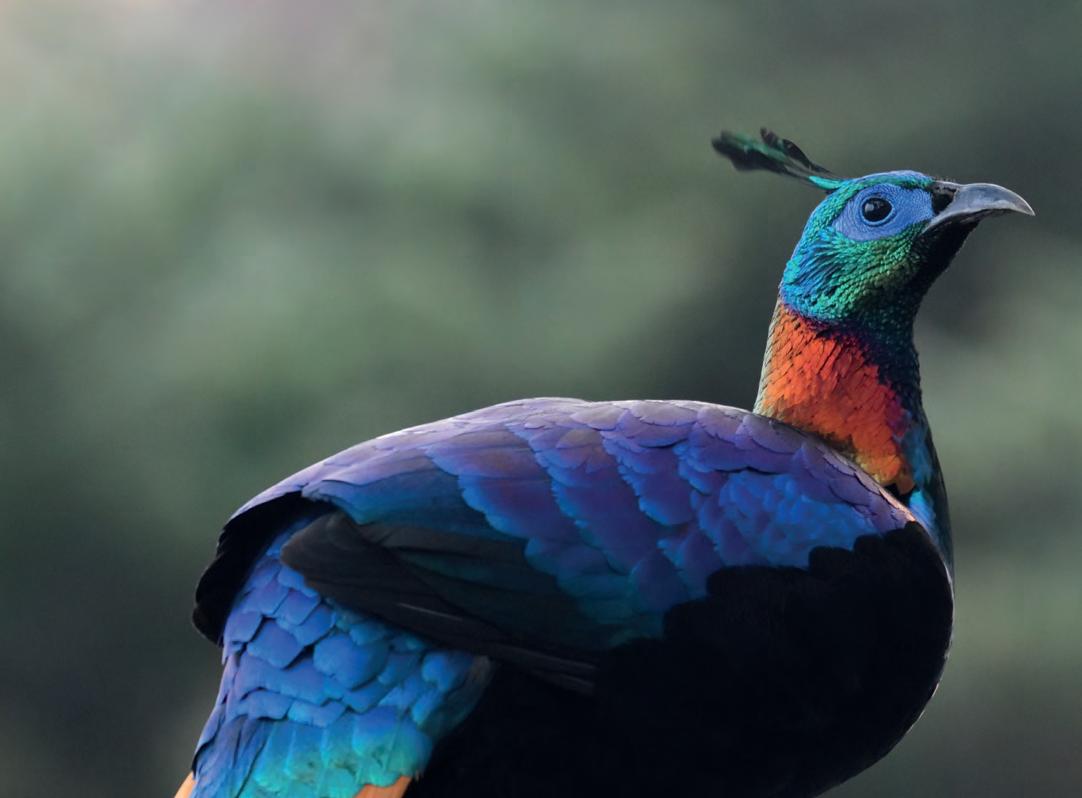



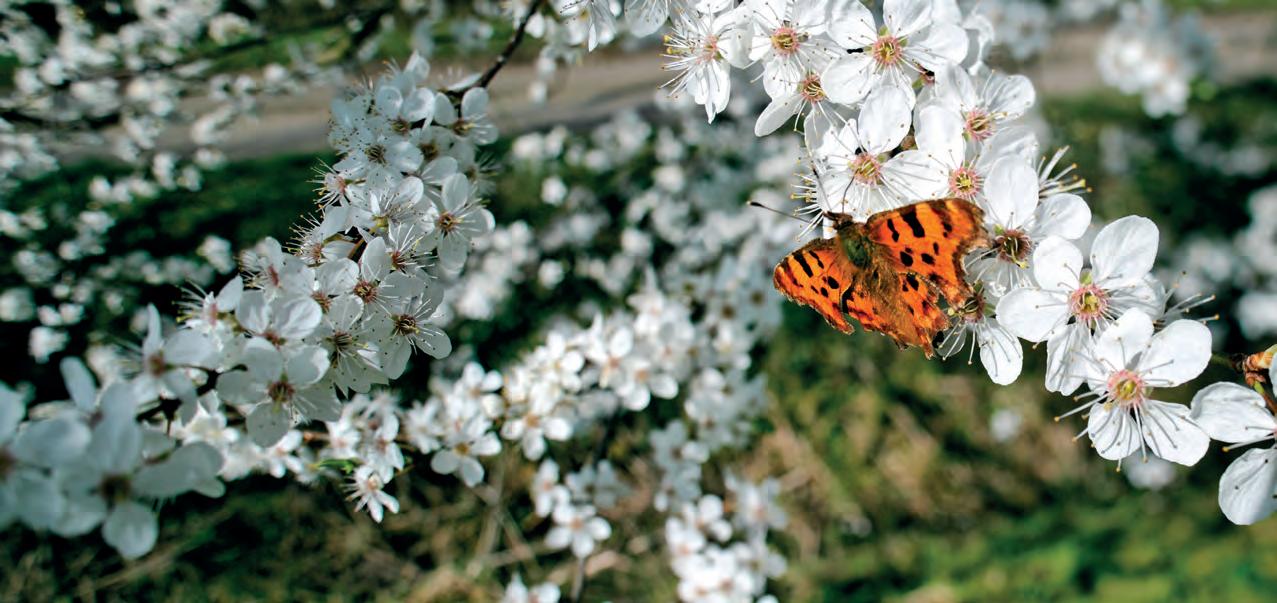
PSH Environmental partners with Norfolk Wildlife Trust to launch new £45,000 conservation fundraising campaign
On a 12-acre enclave of former agricultural land embraced by NWT Foxley Wood, there are signs of spring. Green shoots of dog’s mercury are appearing, as the first wildflowers re-colonise from their stronghold in the surrounding ancient wood. Sprigs of young blackthorn are evidence of natural generation as this former field returns to nature.
These are the very first steps in a long-term project at Foxley. NWT has recently acquired the enclave, on the southwest boundary of the wood, where historic woodland was felled for agriculture many years ago. With
support from PSH Environmental, NWT is undertaking a programme of natural and assisted regeneration which will see the enclave become part of the ancient wood once more.
The Norfolk-based waste management company has pledged to donate £1 from every skip hired over the coming three years. These donations will amount to an estimated £45,000 contribution to our work, with which we will restore life to land that has been missing from this ancient wood for at least 1,000 years. Each PSH skip hired will pay for the equivalent of one square metre of woodland restoration at Foxley

Wood. The funds will also support the delivery of community and school engagement linked to ancient woodland.
Foxley Wood is a National Nature Reserve and Site of Special Scientific Interest comprising 304 acres. The reserve is crucial habitat for a rich woodland flora, including bluebells and a number of orchids, plus a wide range of birds, mammals and scarce invertebrates.
Daniel Parker, PSH Environmental Director, said: ‘We are so excited to be provided with a unique opportunity to re-establish native woodland.
In April we launched a programme of workshops and activities designed to support people, communities and groups acting for nature in their local areas. To find out more about the programme please visit norfolkwildlifetrust.org.uk/ wilder-community
The programme consists of: Group mechanics – including community grants, social media, task leadership and how to set up a friends group. Habitat focus – looking at managing, creating or restoring such habitats as ponds, meadows, woods and reedbeds. Practical tool use – developing skills in scything, peening and safe hand-tool use.
Species focus – including swifts, pollinators and wildflowers. Community focus – a chance to take a tour with communities doing great things for wildlife.
Planning for wildlife – a webinar on how to get the best outcomes for wildlife from planning decisions where you live.


Working in partnership with Norfolk Wildlife Trust, we can enable our communities to purchase a service from a Norfolk company, in the knowledge that we are investing in the county. Our customers will be able to visit Foxley Wood and see the project as it takes place. It’s the complete circle and it’s something we are very proud of.
‘It is time for businesses to step up to the environmental task ahead, and we are proud to be at the forefront of this type of project. It means a lot to us to become a part of Foxley Wood’s history, and provide a unique piece of nature for generations to come.’
James Hogg, NWT Corporate and Membership Development Officer, added: ‘PSH Environmental, like us, cares deeply for our beautiful county. We are delighted to welcome them into our Investor in Wildlife scheme, which allows businesses in the area to support Norfolk’s wildlife.’
To find out more about PSH Environmental’s ‘Clean up to green up’ campaign, and see a running total of funds raised to date, visit parkersskips.com/clean-up-to-green-up.
Our historic commons across the county are part of what makes Norfolk special. They are brilliant for wildlife and great places to explore. Why not join us this July for a week-long celebration of Norfolk’s commons?
All activities are free. Booking essential: online at Eventbrite, via the NWT website.
Elephants, tigers and pugs
Saturday 2 July, 9 to 11am
Join us as we open a moth trap to discover some of the beautiful moths that live in Shotesham. Having opened the trap, we will go for a walk on the common in search of wildlife.
Location: Shotesham Common
Hoe Common: history, wildlife and conservation
Sunday 3 July, 10.30am to 12.30pm
A 19th century enclosure, a fuel allotment for the poor, military trenches, a boundary of ancient oaks, biodiverse acid heathland: these are just some of the things that make Hoe Common so special.
Location: Hoe Common
A Common History
Tuesday 5 July, 7.30 to 9pm
Join Tom Williamson, Professor of Landscape History at UEA, for a talk on the history of commons in general and how the common at New Buckenham has been used throughout history.
Location: New Buckenham Village Hall


WORDS BY PATRICK BARKHAM, NATURAL HISTORY WRITER AND NWT PRESIDENT
Those who remember the Blair Witch Project may beg to differ but I defy you to spend half-an-hour strolling through a wood and not immediately feel calmer, refreshed and healthier. When do you come away from a trip to the shops feeling so well?
Woodland ‘bathing’ may be a Japanese concept but most of us intuitively know that quiet time surrounded by trees is good for us, even though we probably don’t do enough of it. We worry about trees and England’s woodland cover (10%) is one of the lowest in Europe, far less than France or Finland, but woods are making a comeback.
Faden’s 1797 map of Norfolk reveals fewer woods than today. In fact, the story of the 20th century is of fairly disastrous forest-creation, with the mass planting of non-native conifers damaging peat bogs, heaths and ancient woodland.
This was the fate that befell Foxley Wood, Norfolk’s largest ancient woodland, in the 1960s, when ancient oaks were uprooted and burned and venerable coppice sprayed with chemicals so that half of it could be replanted with conifers that shaded out all the woodland flora – and most of its life. I grew up in Reepham, a few miles from Foxley, and every summer in the 80s
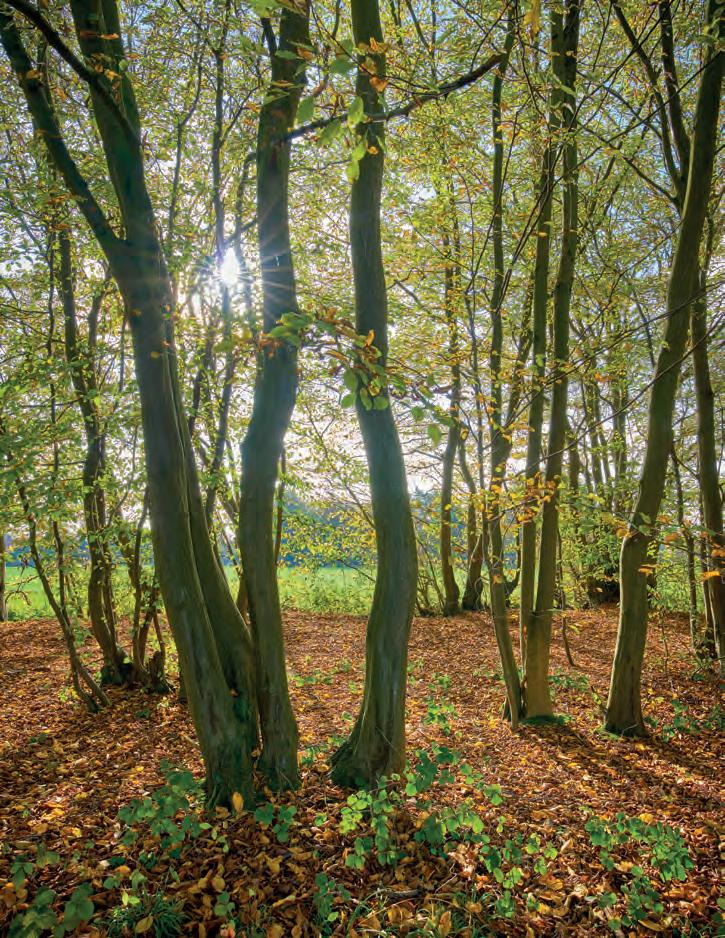
my dad and I would walk the woods to search for the purple emperor, a thrilling iridescent-purple treetop butterfly, which had become extinct in Norfolk and was last seen in Foxley. We never found it: the conifers supplanted the sallow it needed to survive.
Foxley has since witnessed a stunning renaissance. My dad, John, who was an ecologist at UEA, played a key role in persuading the Trust to acquire Foxley Wood. Under the Trust’s care, the conifers were removed in the 1990s and the southern wood allowed to regenerate naturally.
Today, Foxley explodes with life: in July, sunny, floral glades dance with brown hawkers, silver-washed fritillaries
and, yes, the purple emperor, which has returned to Norfolk thanks to the restoration of places like Foxley.
Everyone flocks to Foxley but there are glorious NWT woods all over Norfolk: mystical Wayland, tranquil Ashwellthorpe, and wooded corners on almost every reserve. I love the lesservisited glades of Thompson Common, Alderfen Broad and Booton Common. Try Hickling for a wood-edge swallowtail!
The current national push for more trees to sequester carbon is welcome but our mantra must be right-tree-in-the-rightplace. And even conifers have their place: the pinewoods at Holme are not ‘natural’ but they too are a sheltered, scented sanctuary for birds and people today.


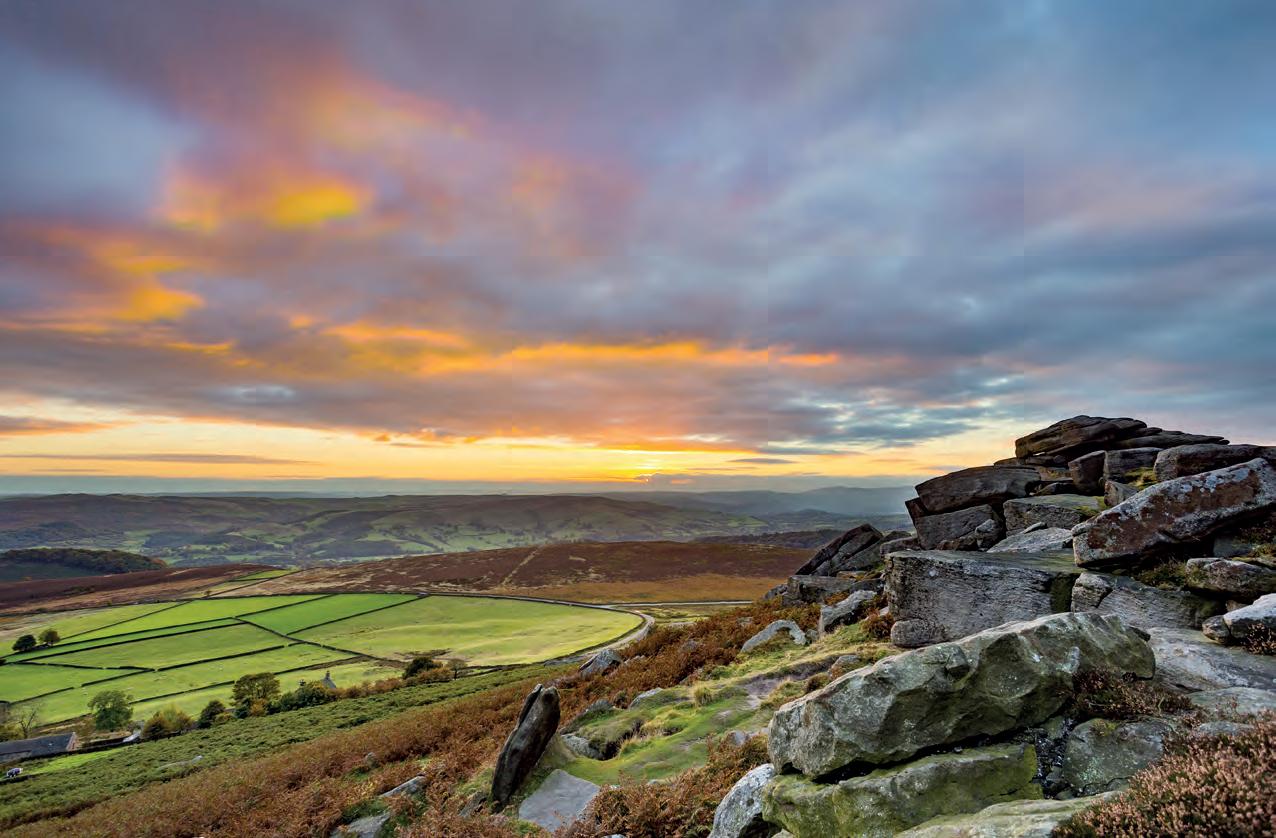




Enjoy the great outdoors from the comfort of a coach. We offer Tour Manager escorted Coach Holidays from more than 300 local departure points, all staying in comfortable accommodation on a half board basis, with sightseeing trips included! With nearly 40 years in coaching, we are experts in our field and think you will simply love our holidays as much as we do.

Exclusively for adults Free local joining points Tour Manager escorted Complete luggage handling service on all coach holidays*
*Excludes the Channel Islands


No single room supplements on UK Mainland Coach Holidays
Tried, tested and respected for more than 35 years
Fully ABTA bonded for your complete security



For your chance to win this fabulous
simply call to request a copy of our













